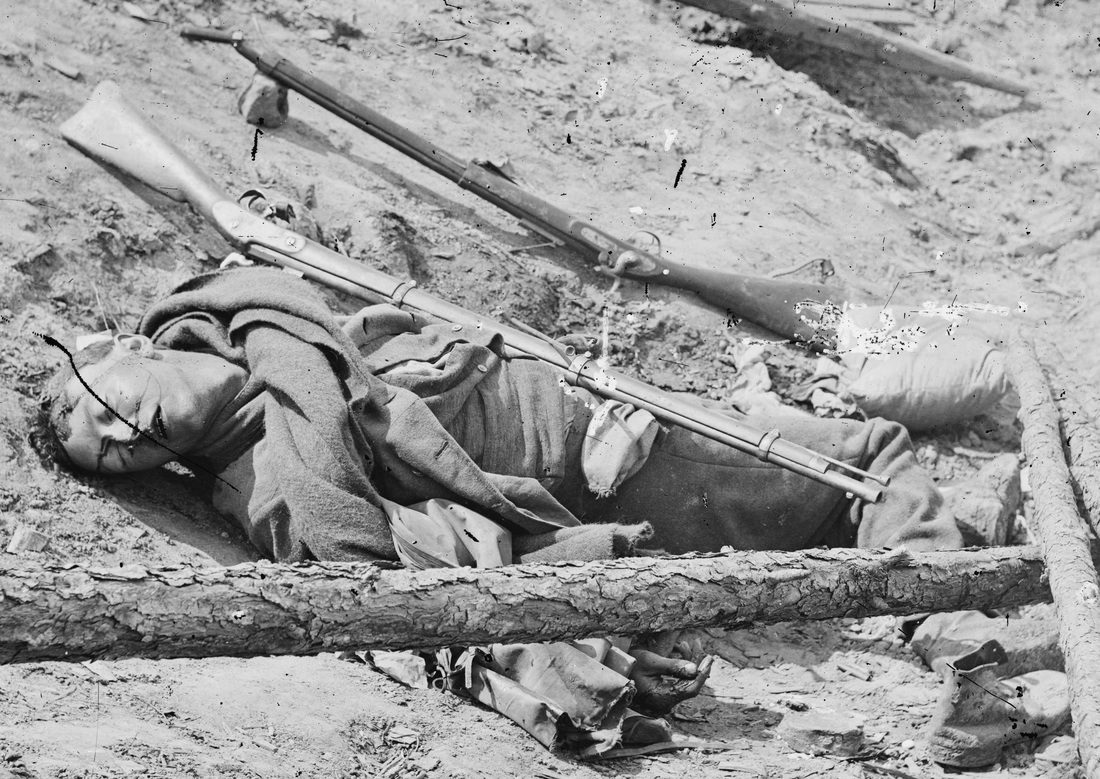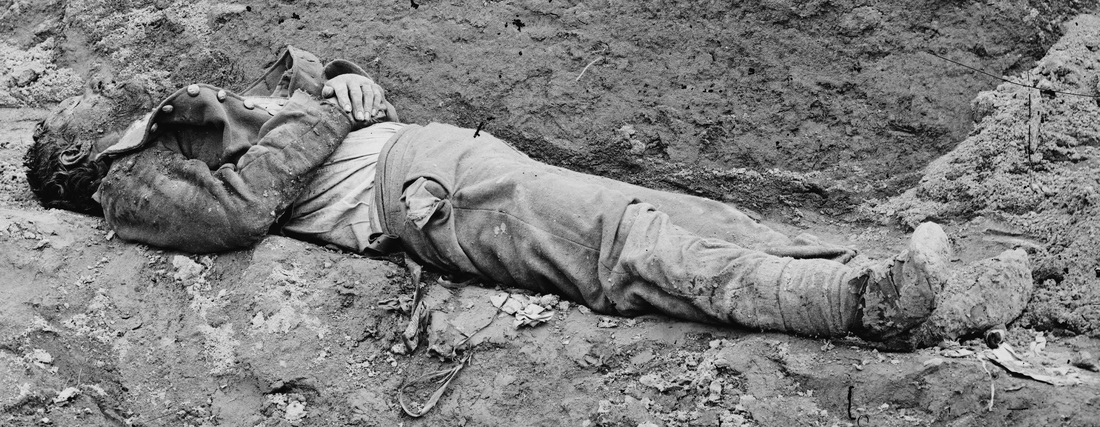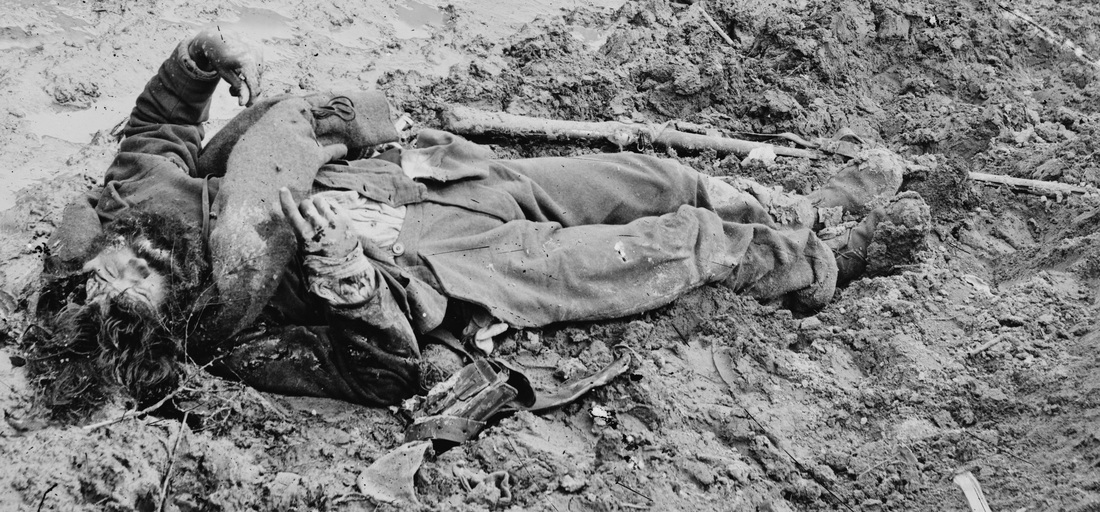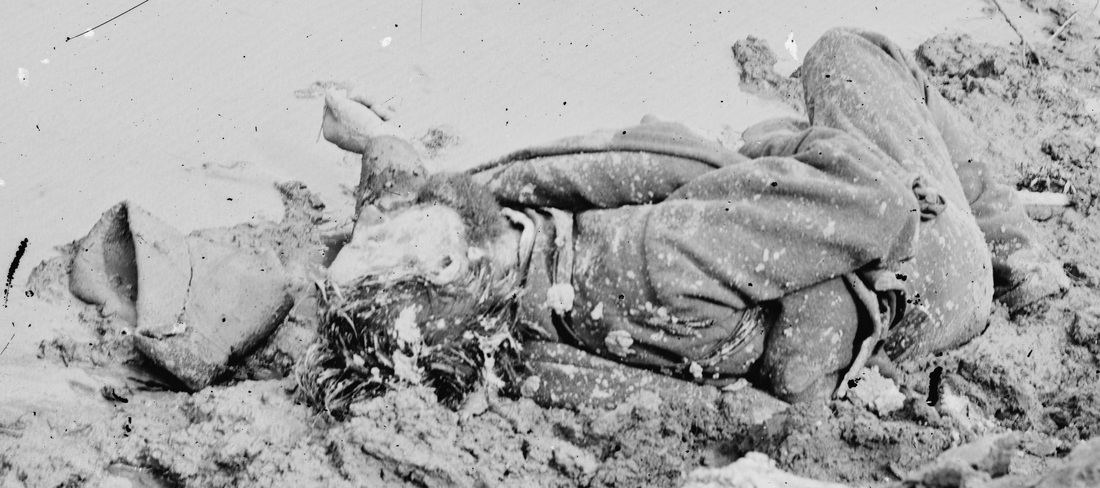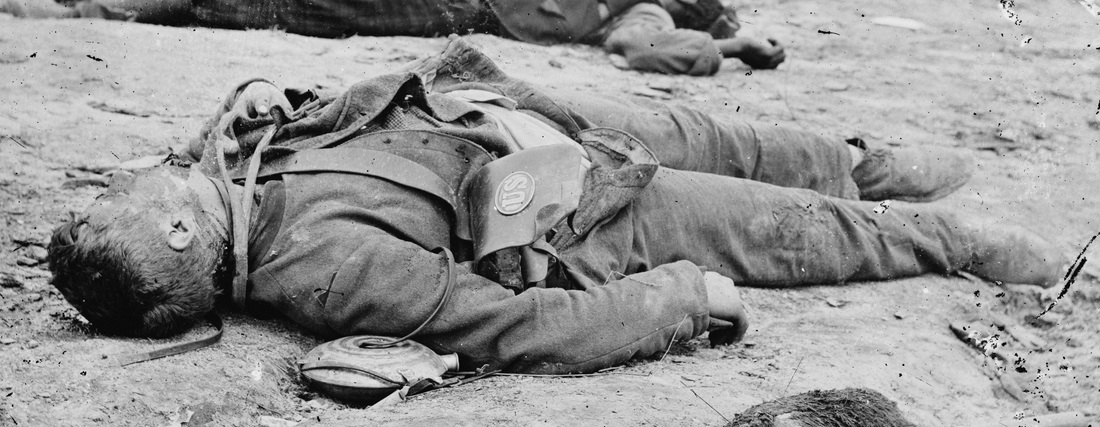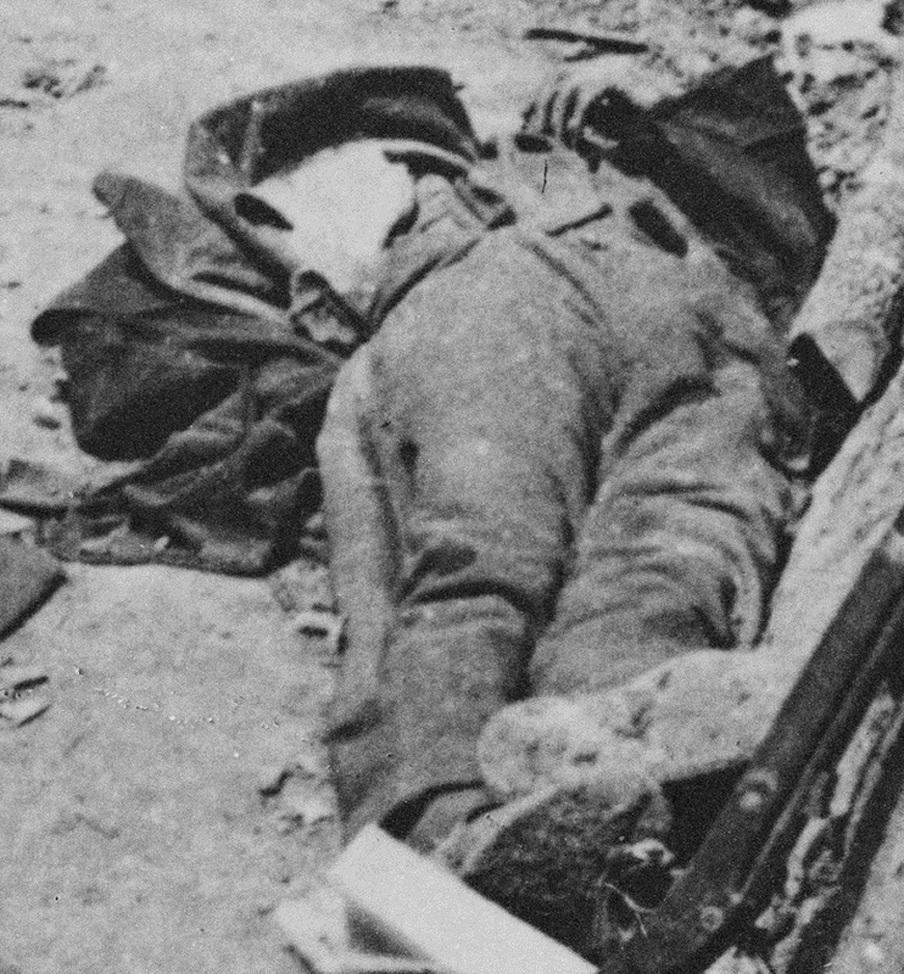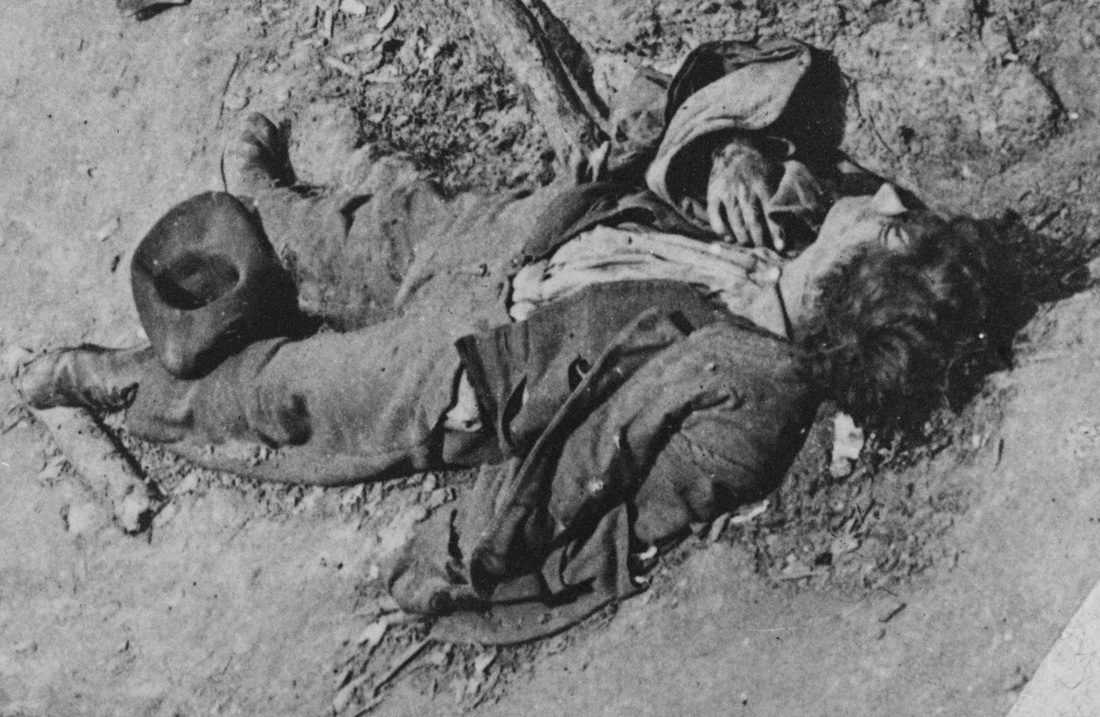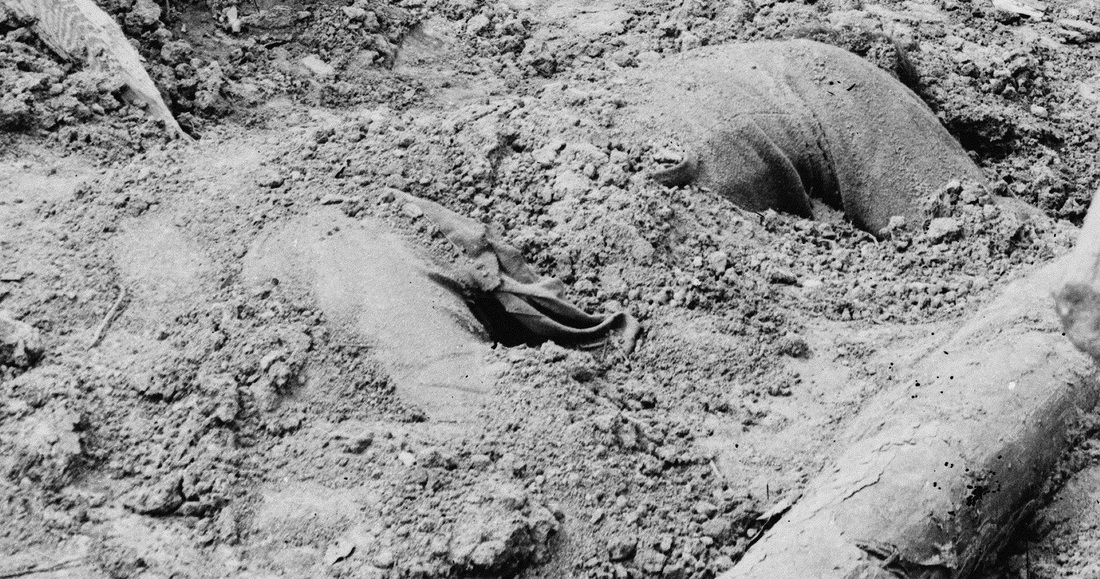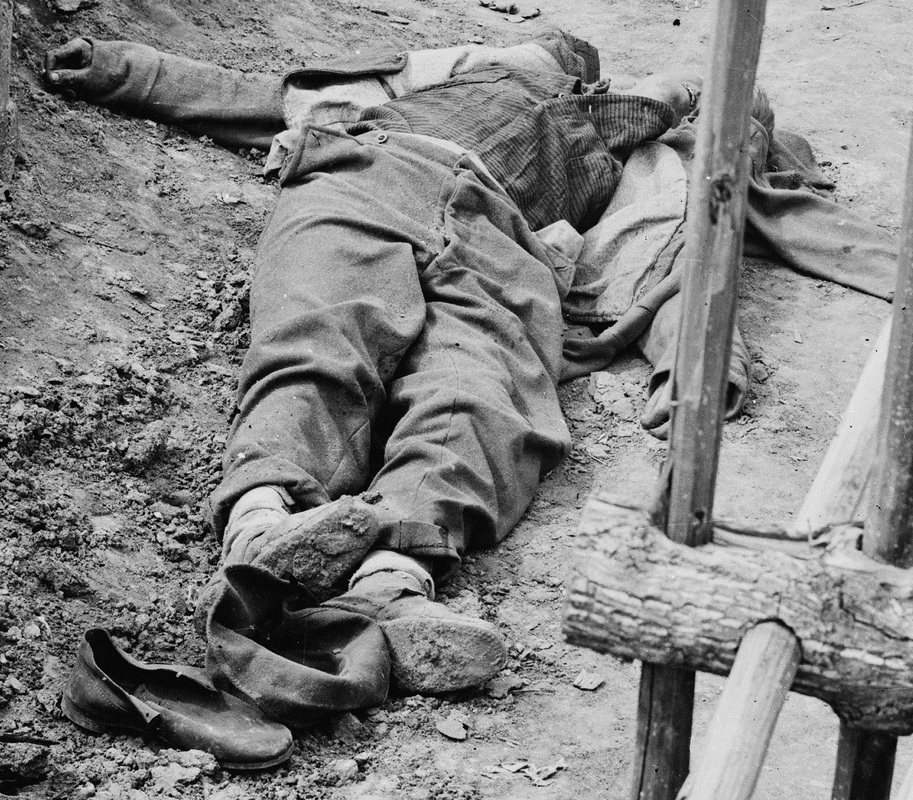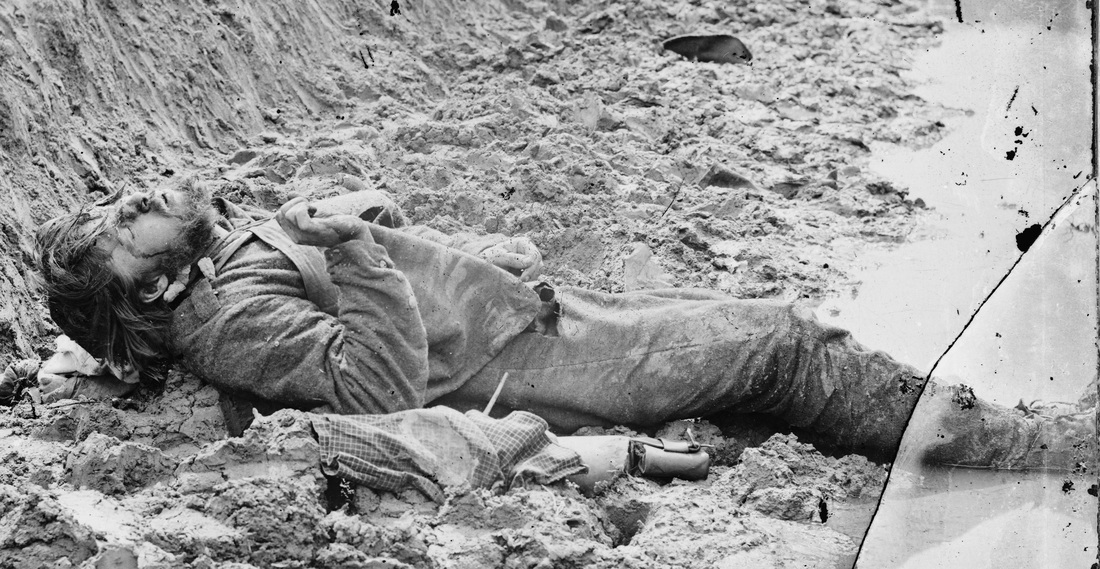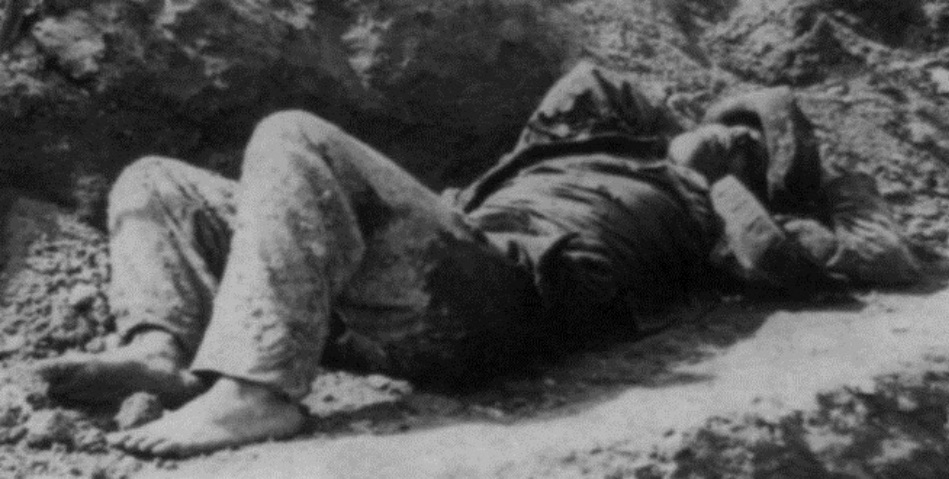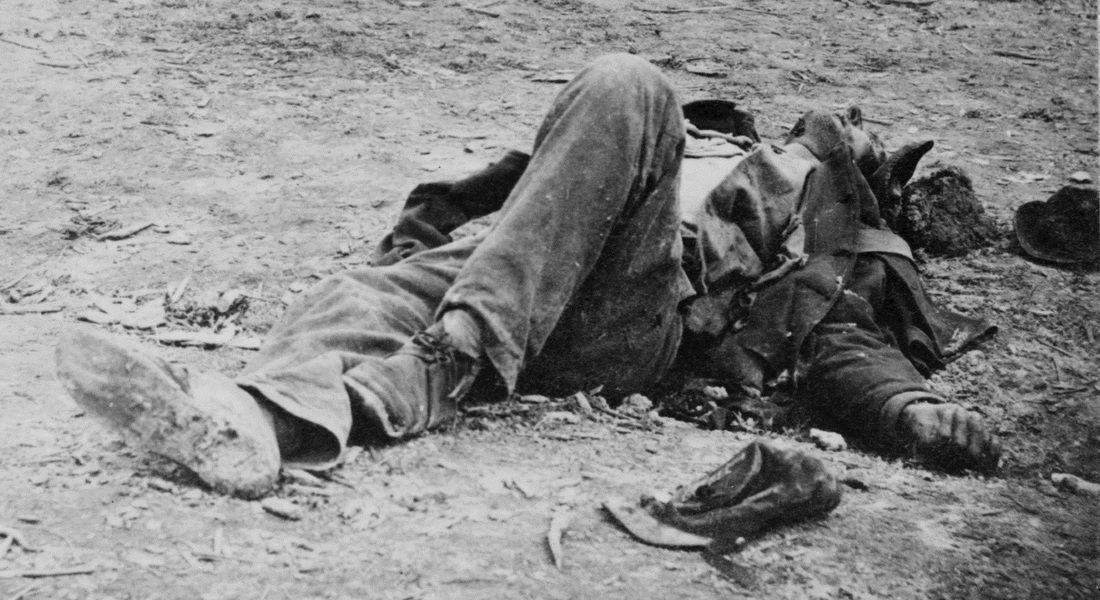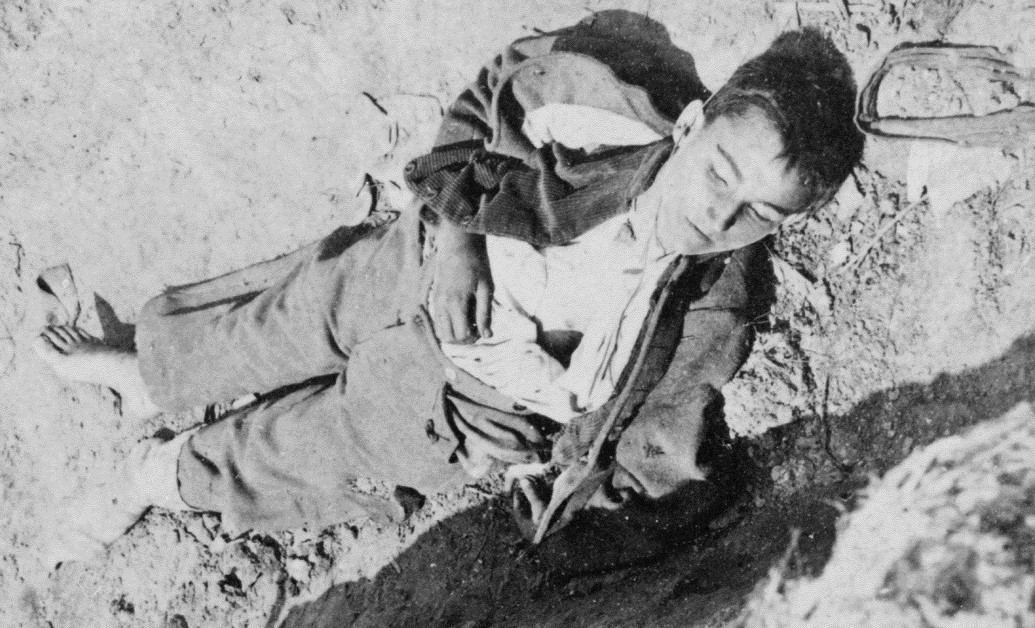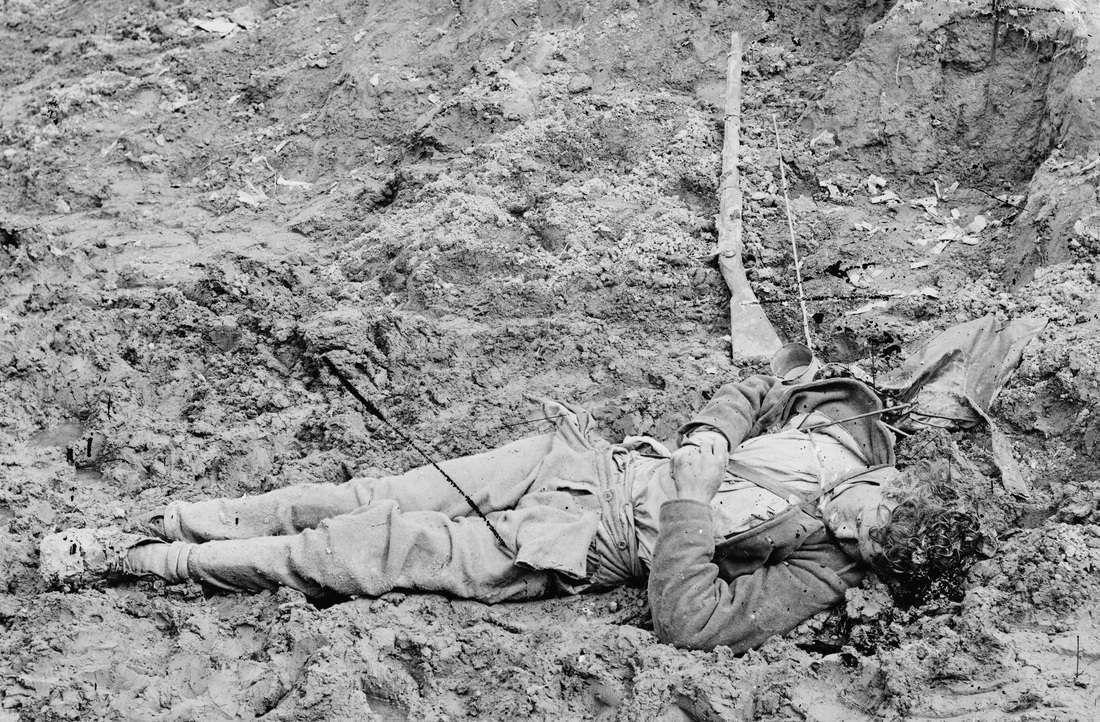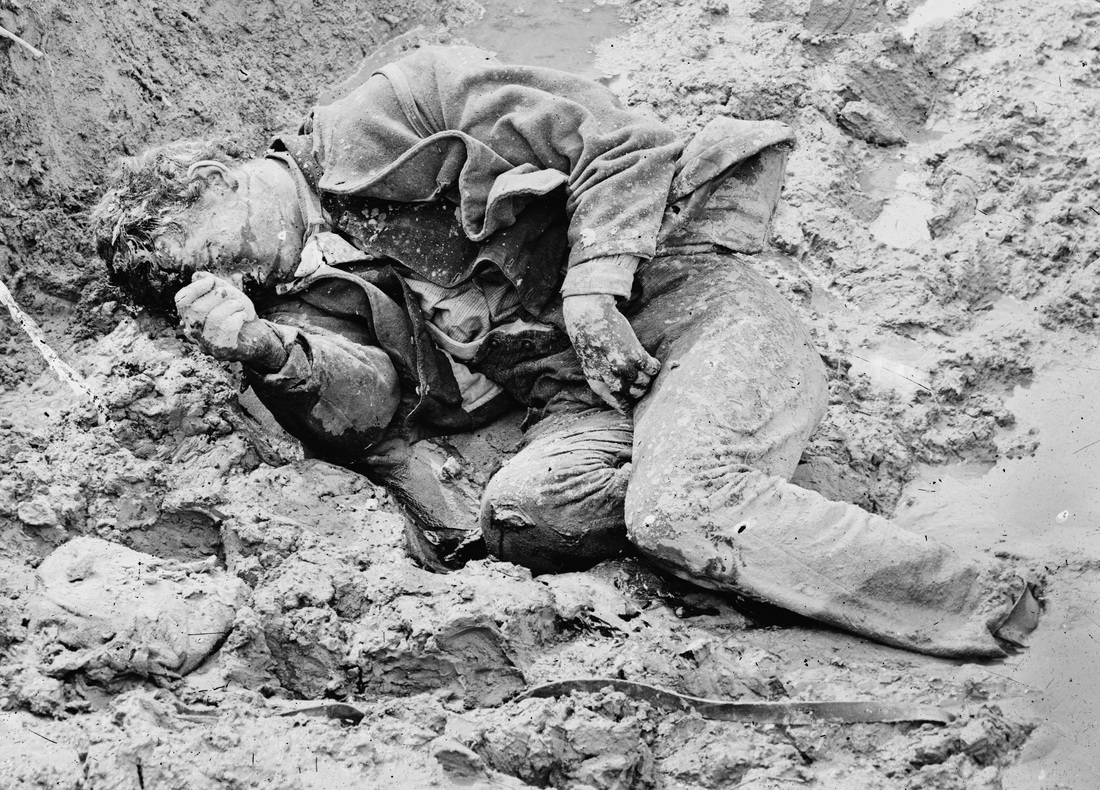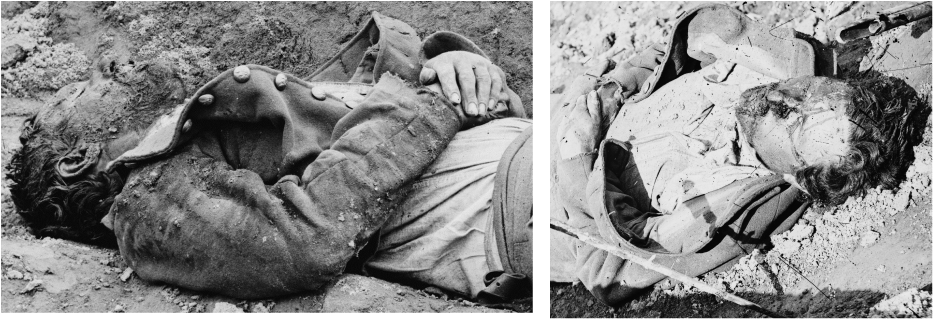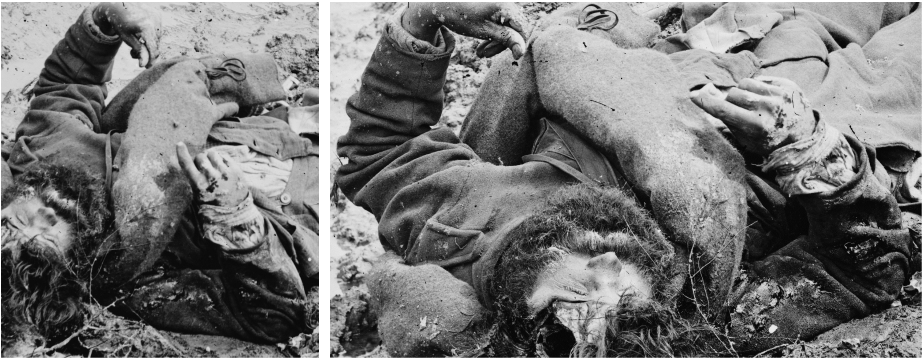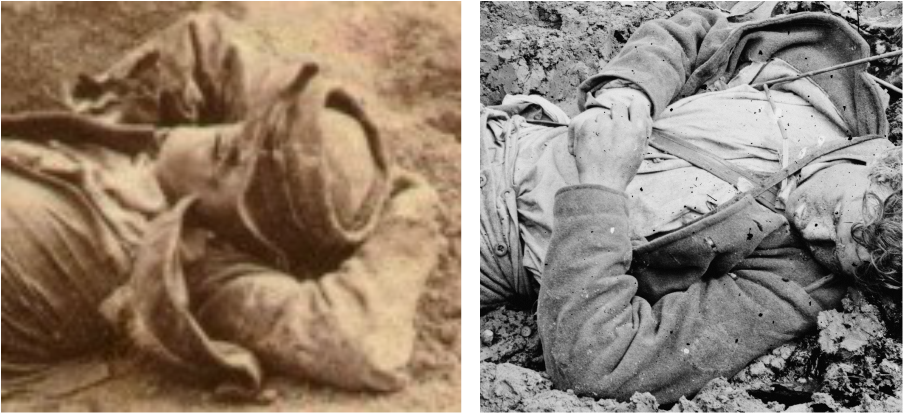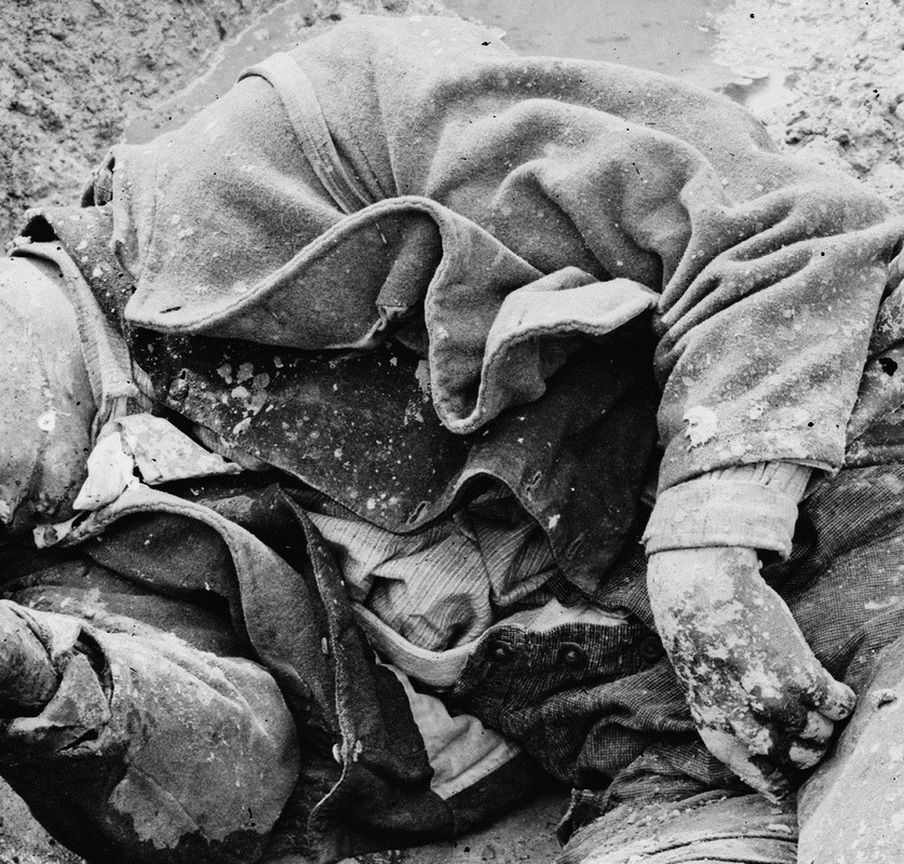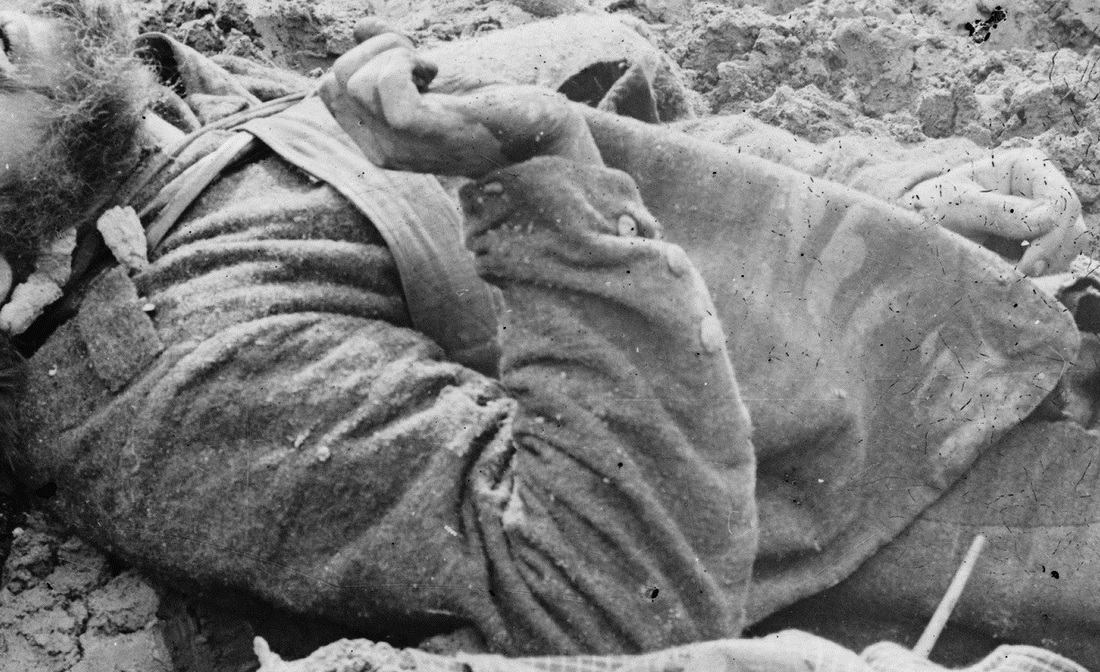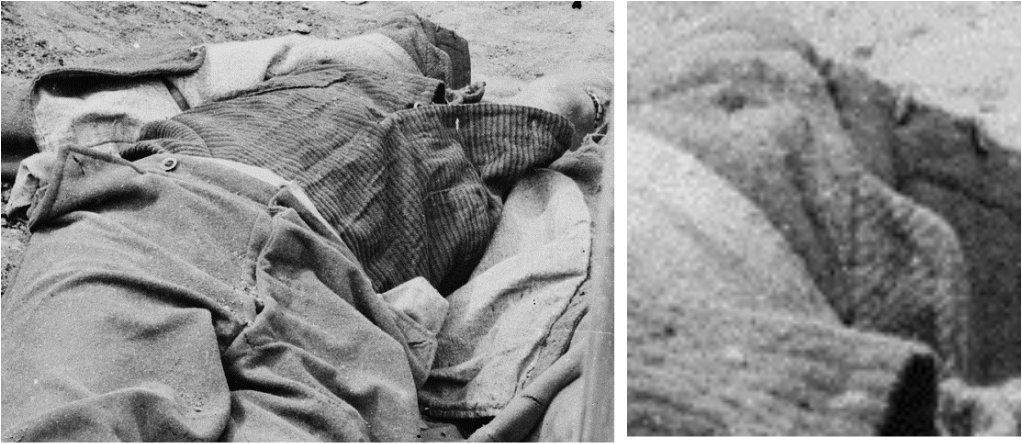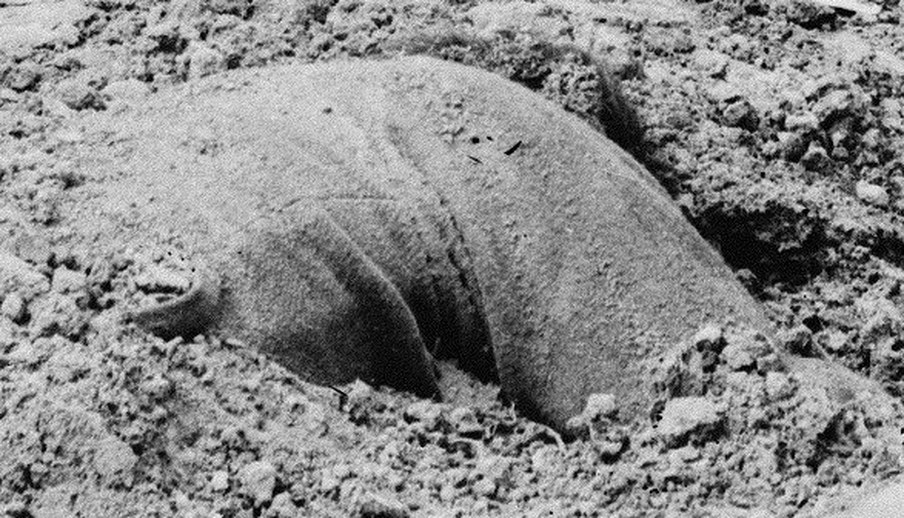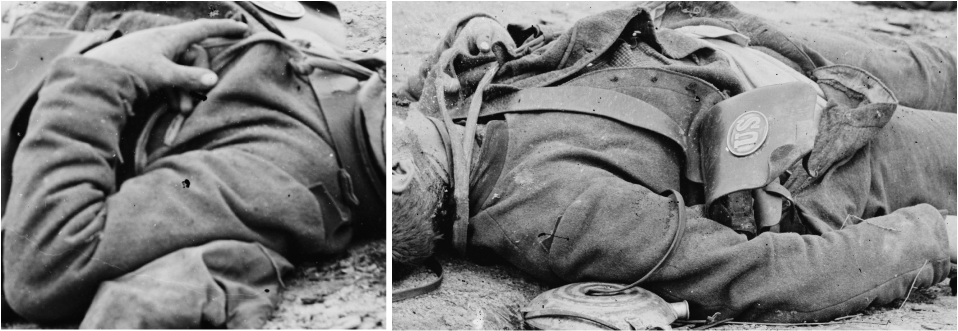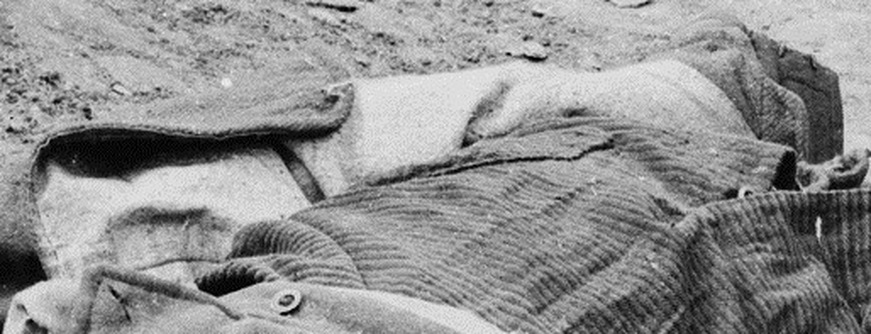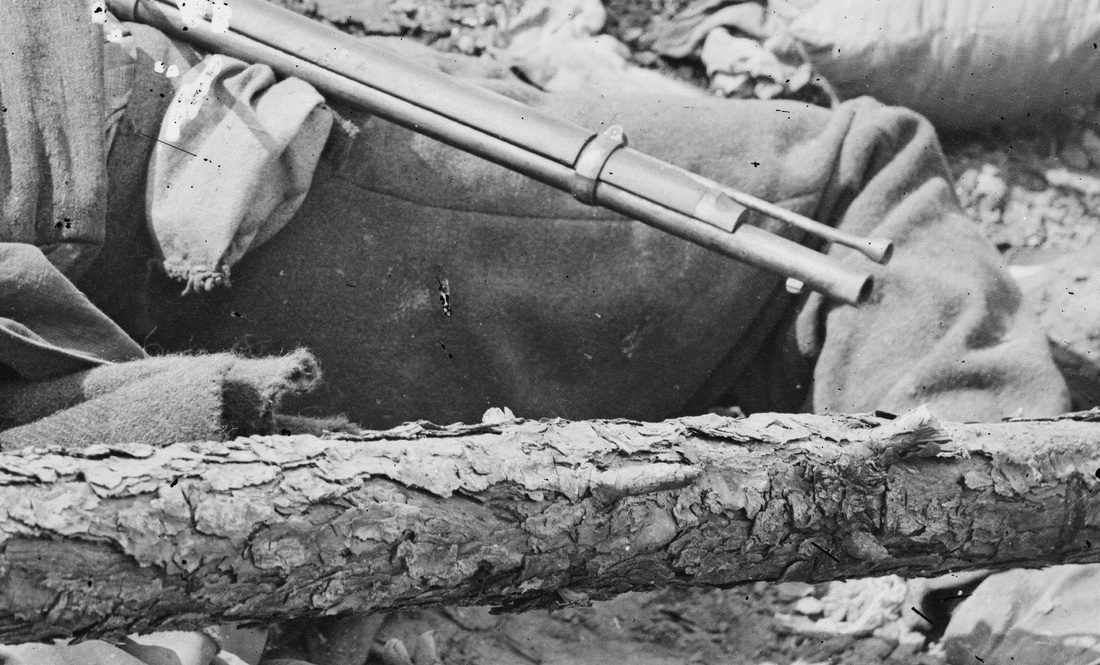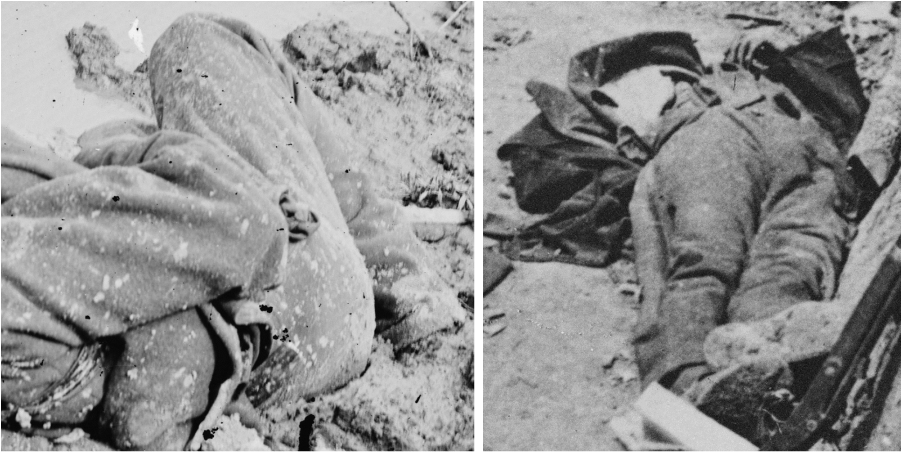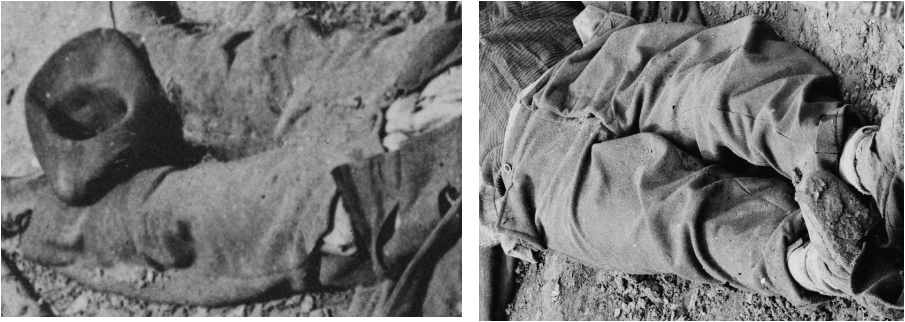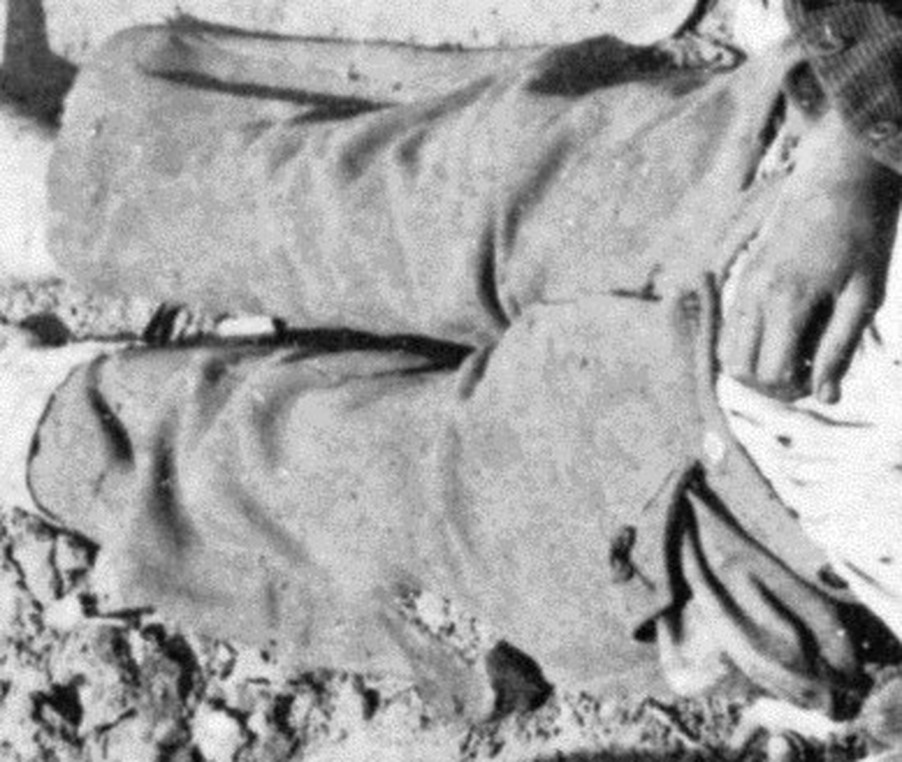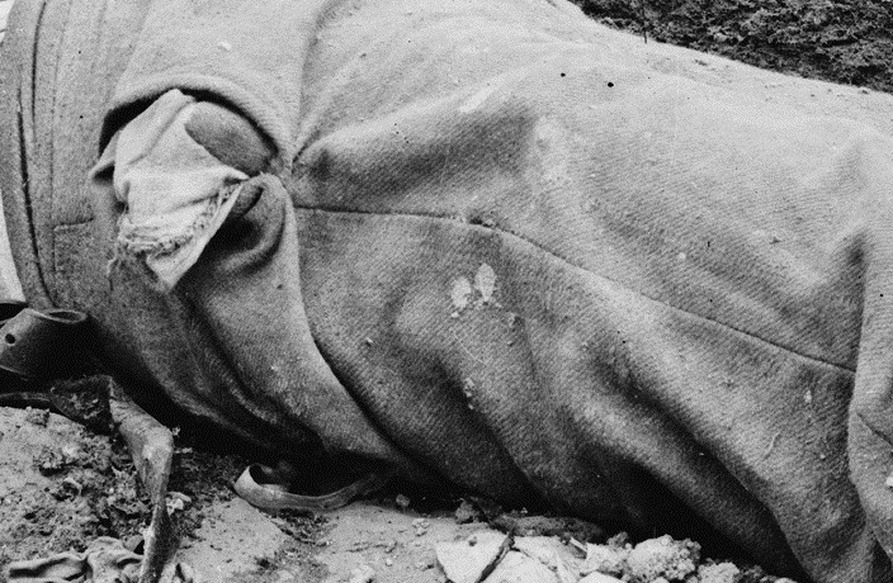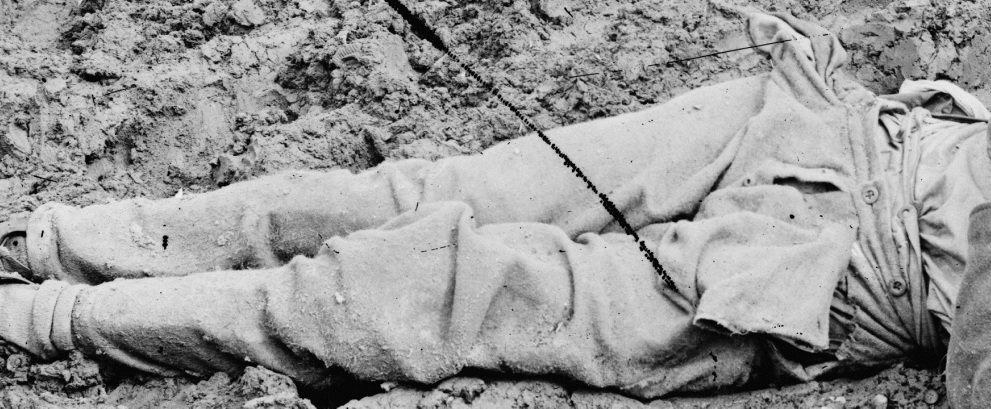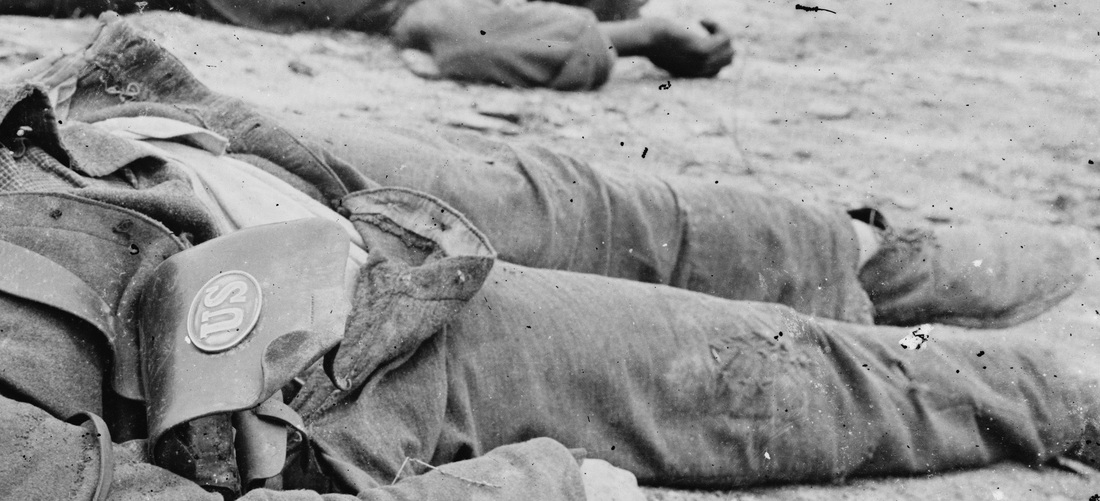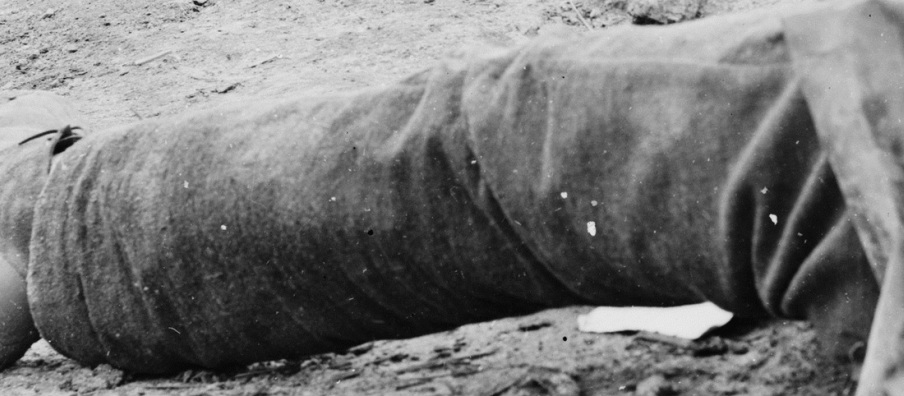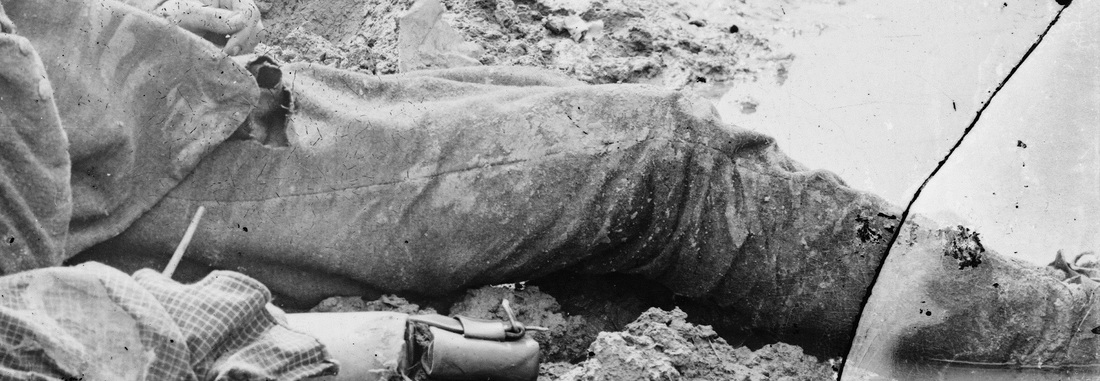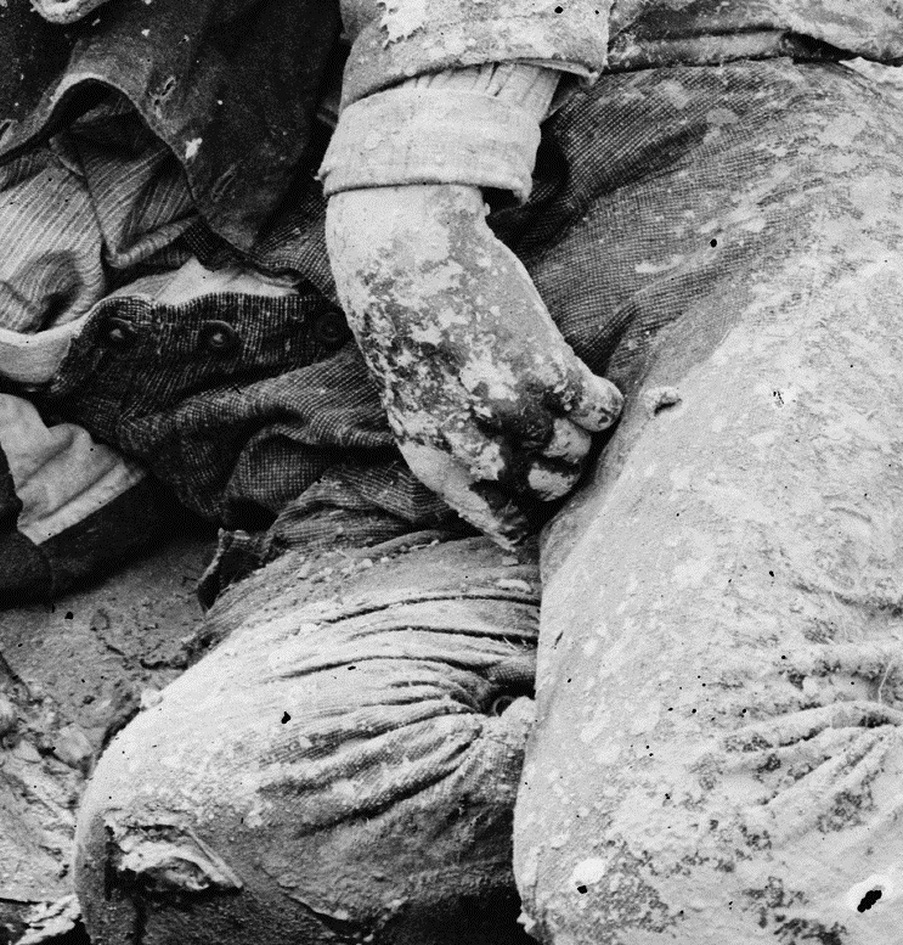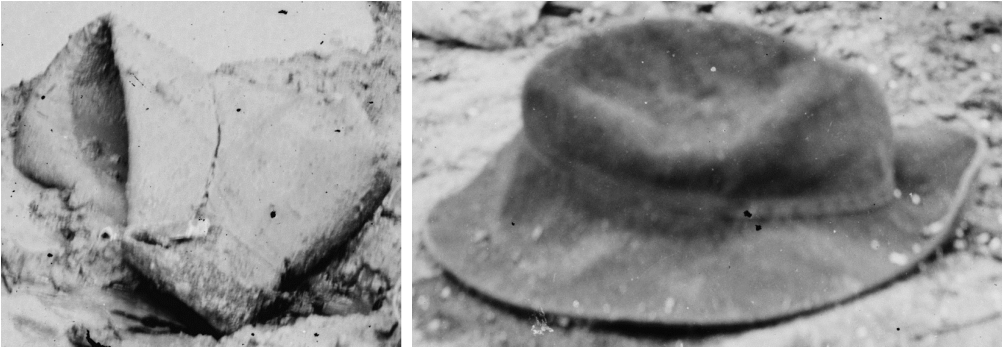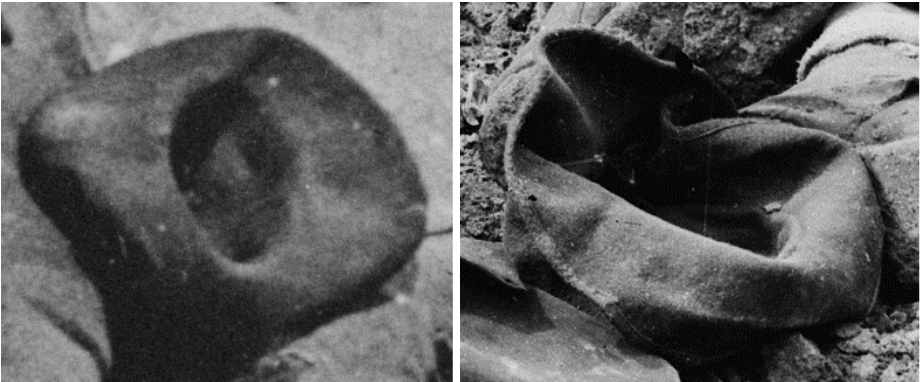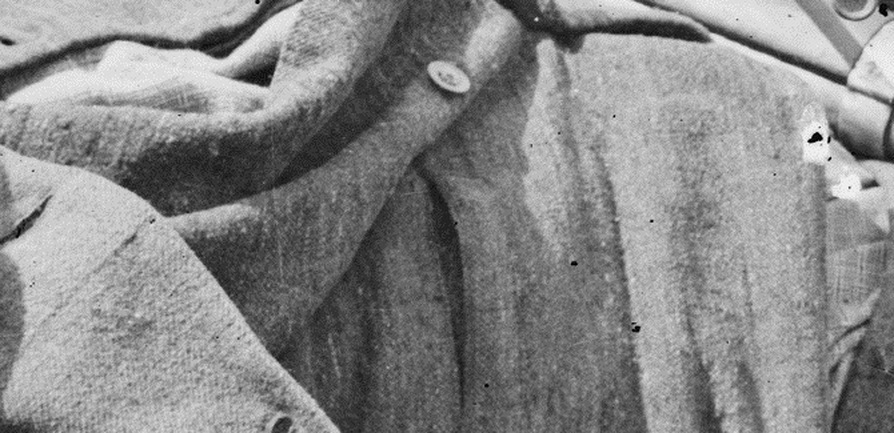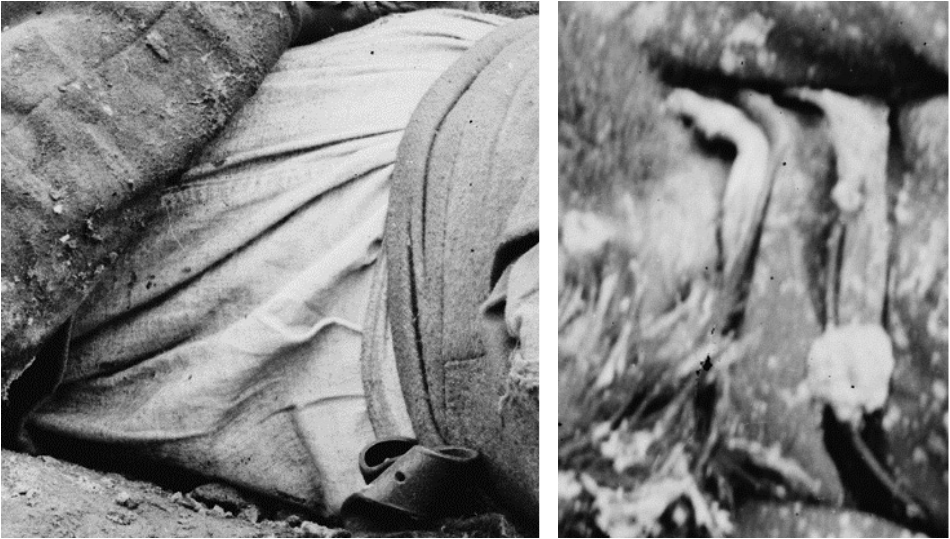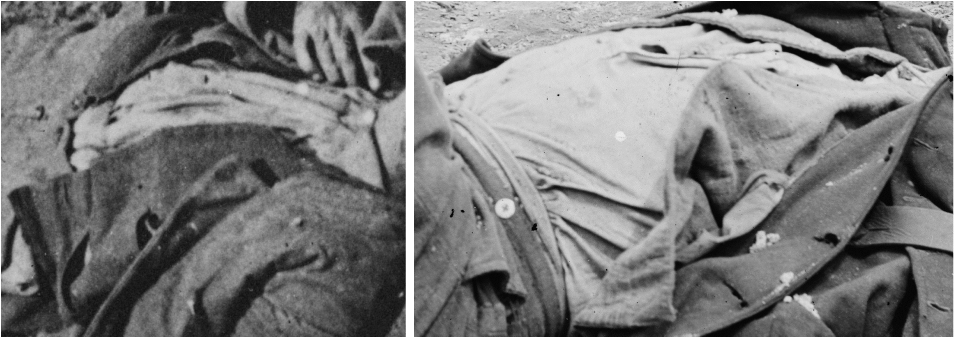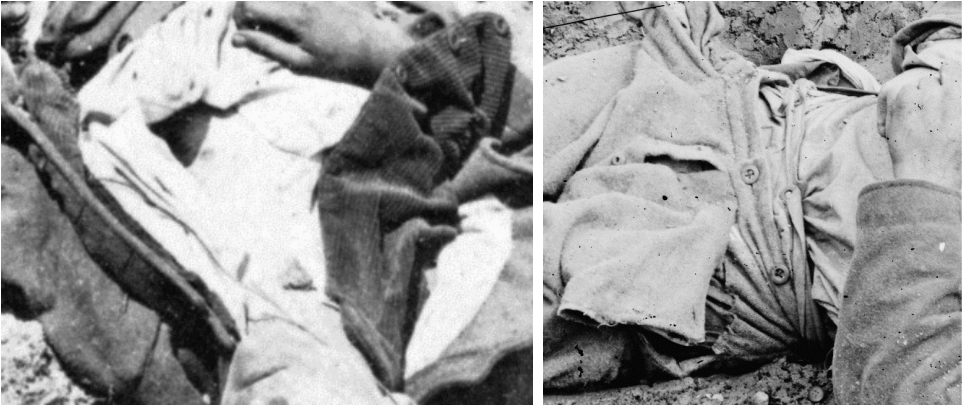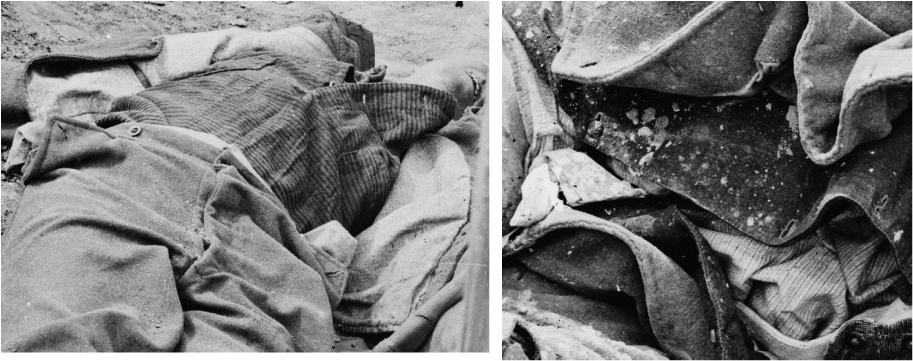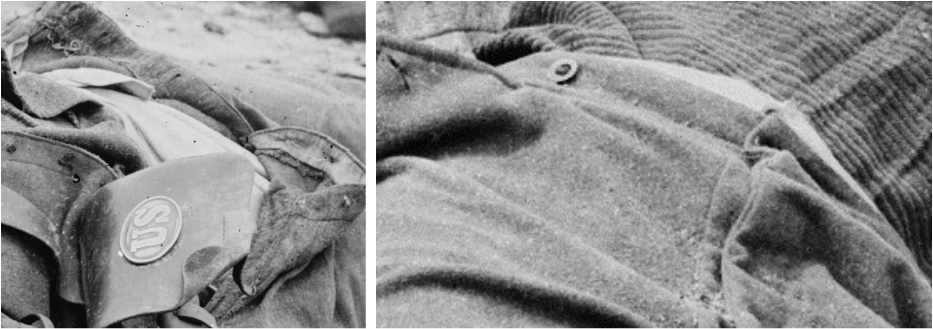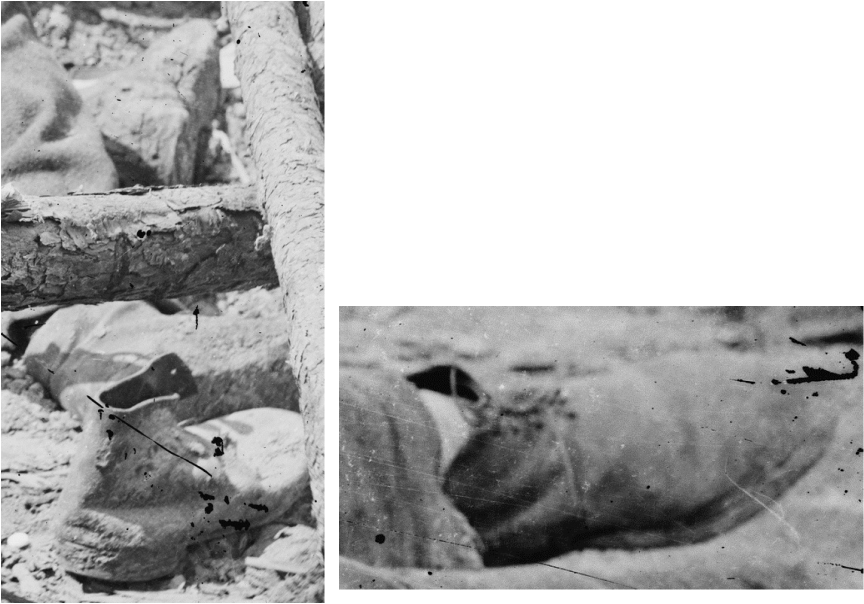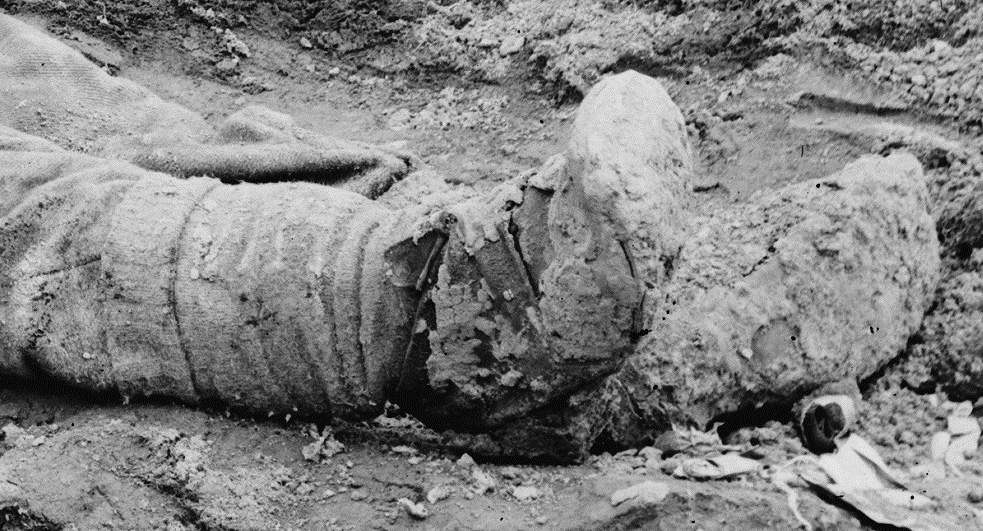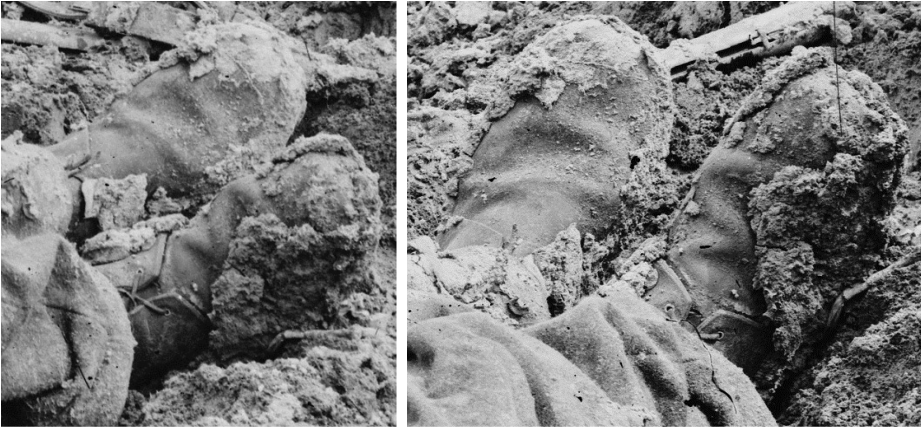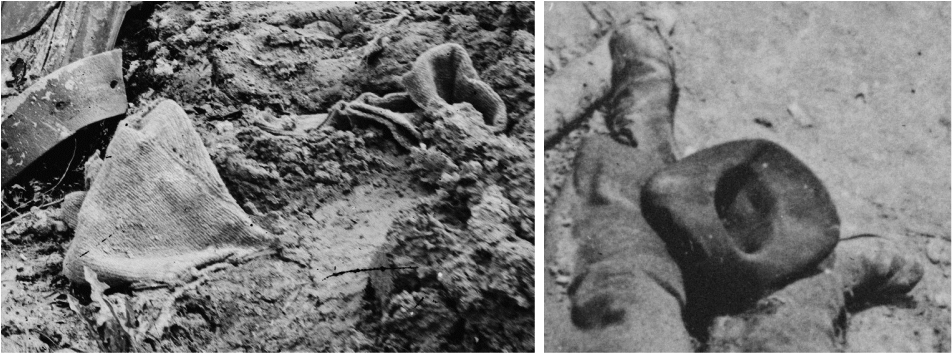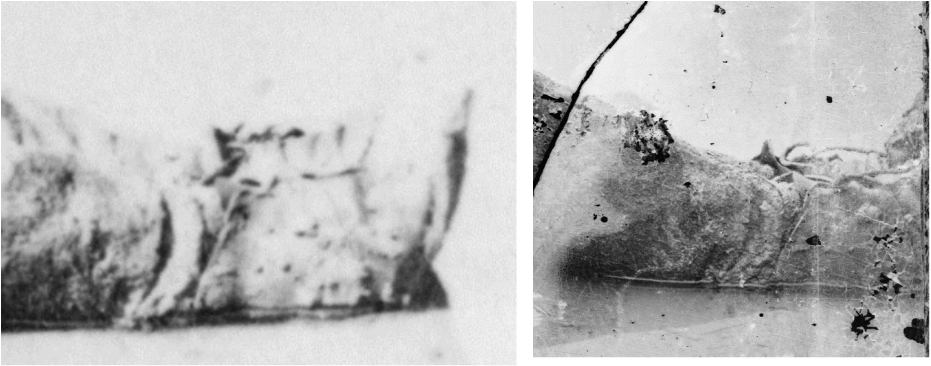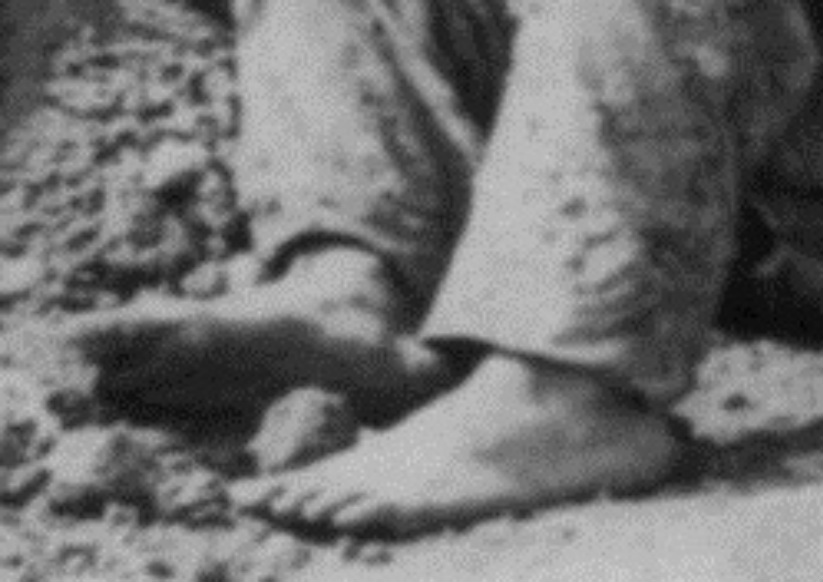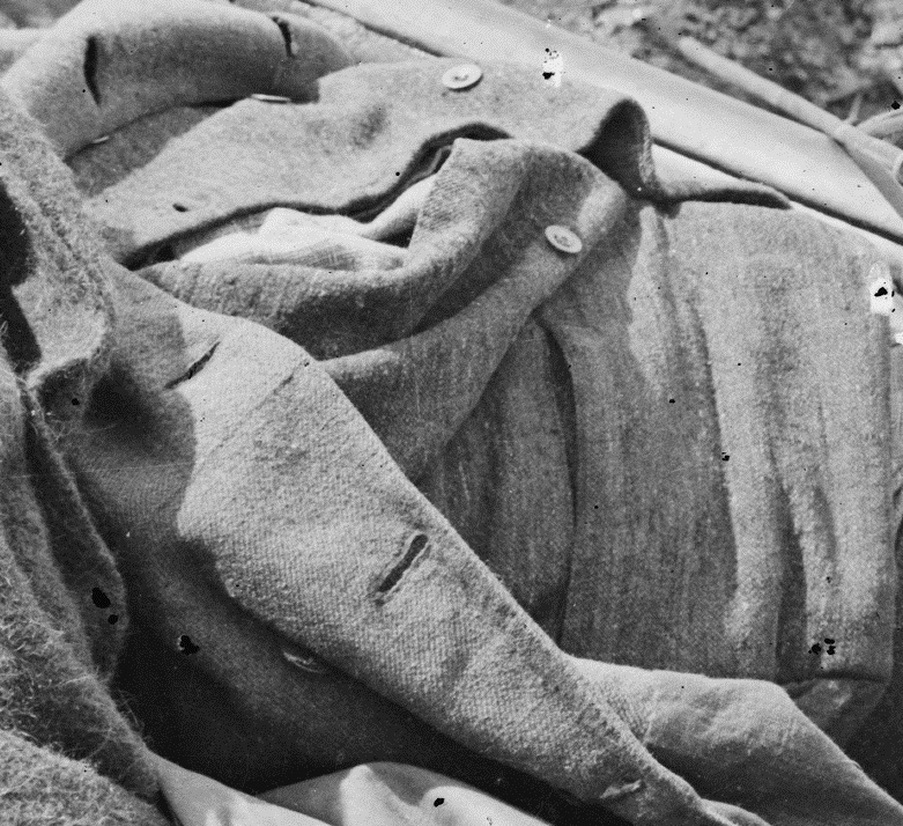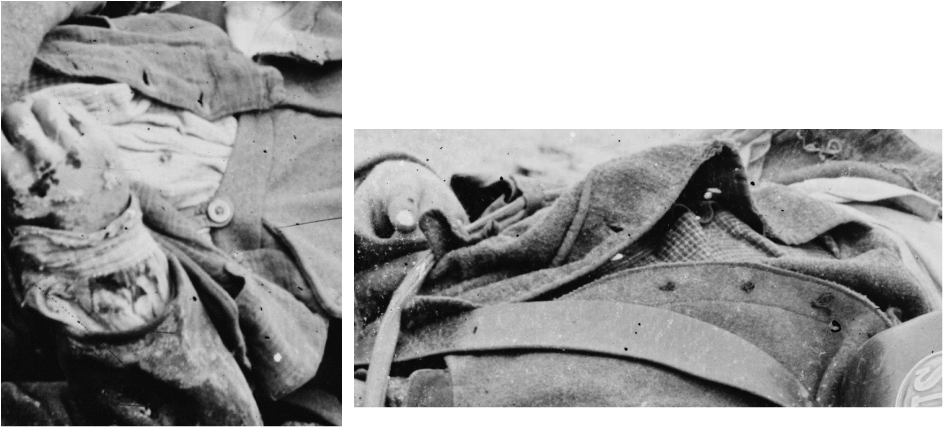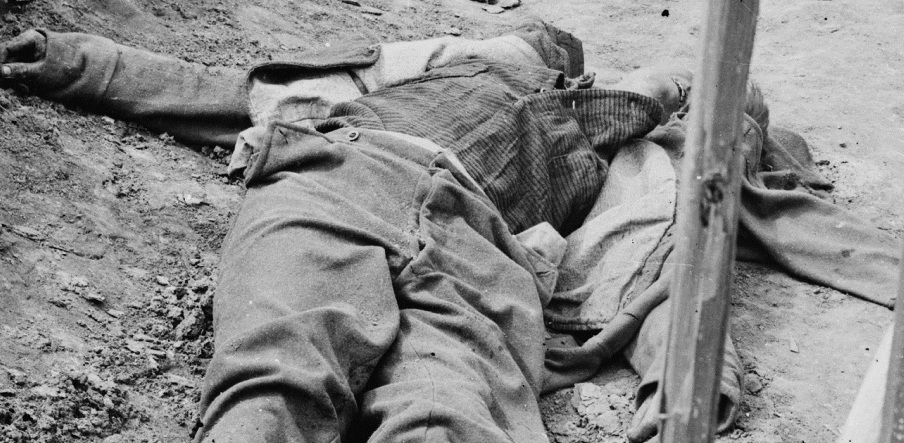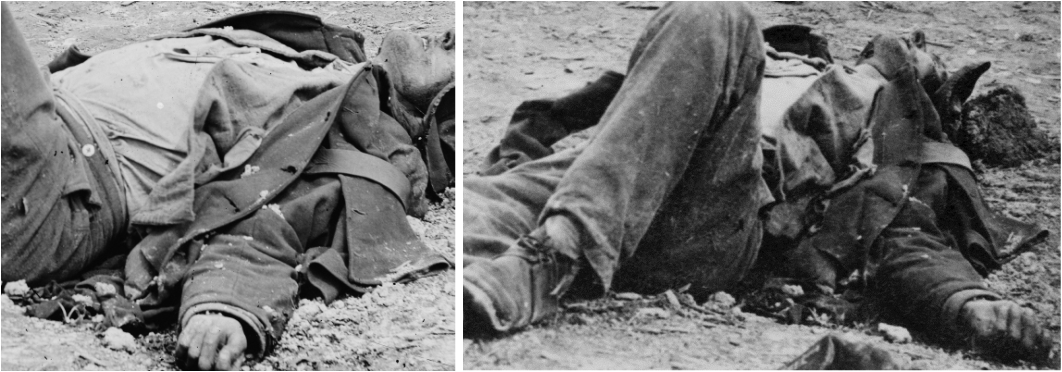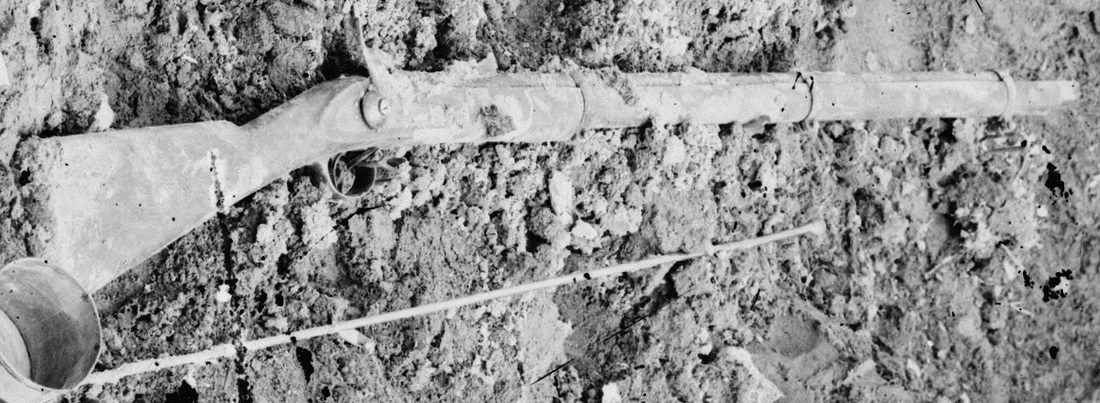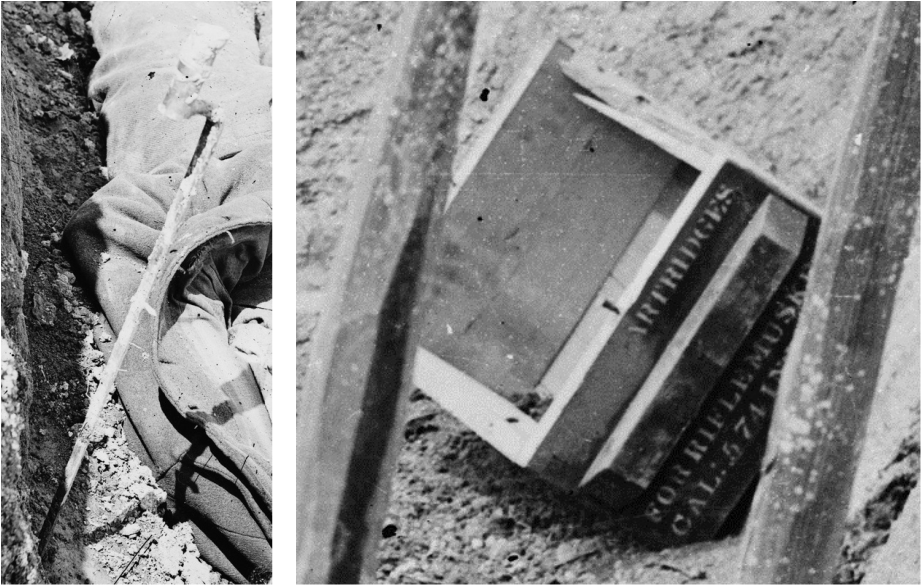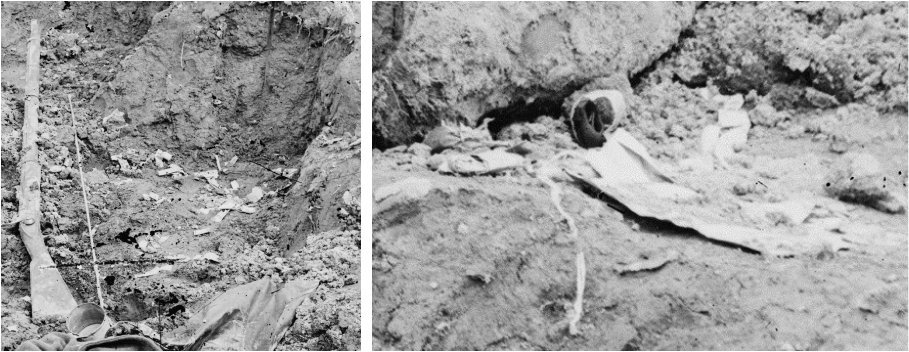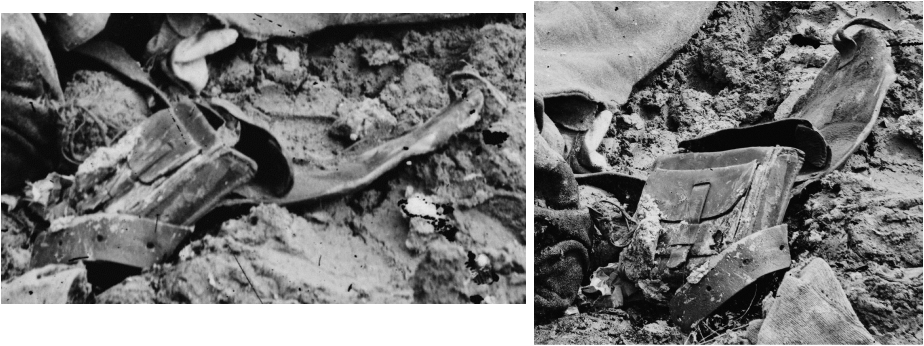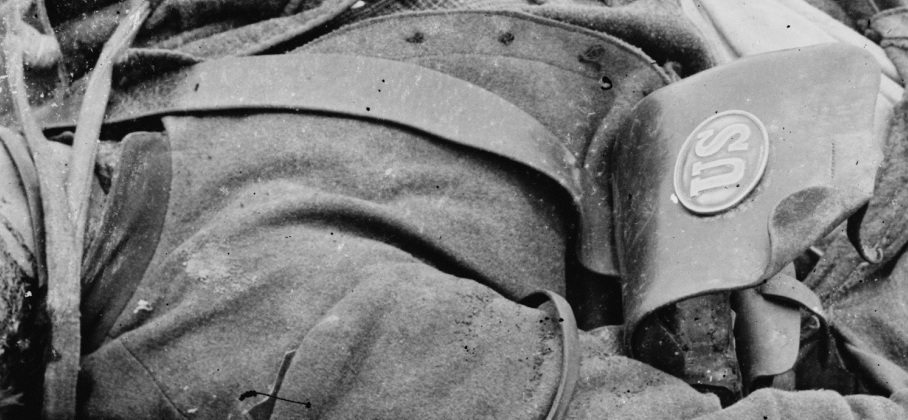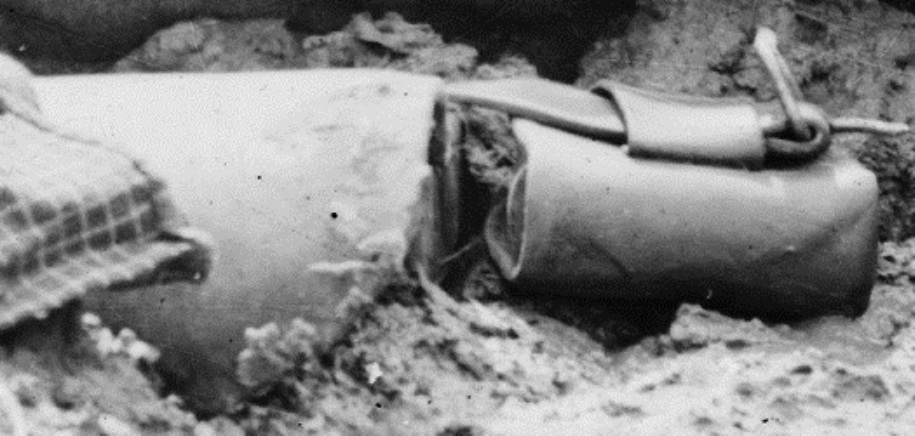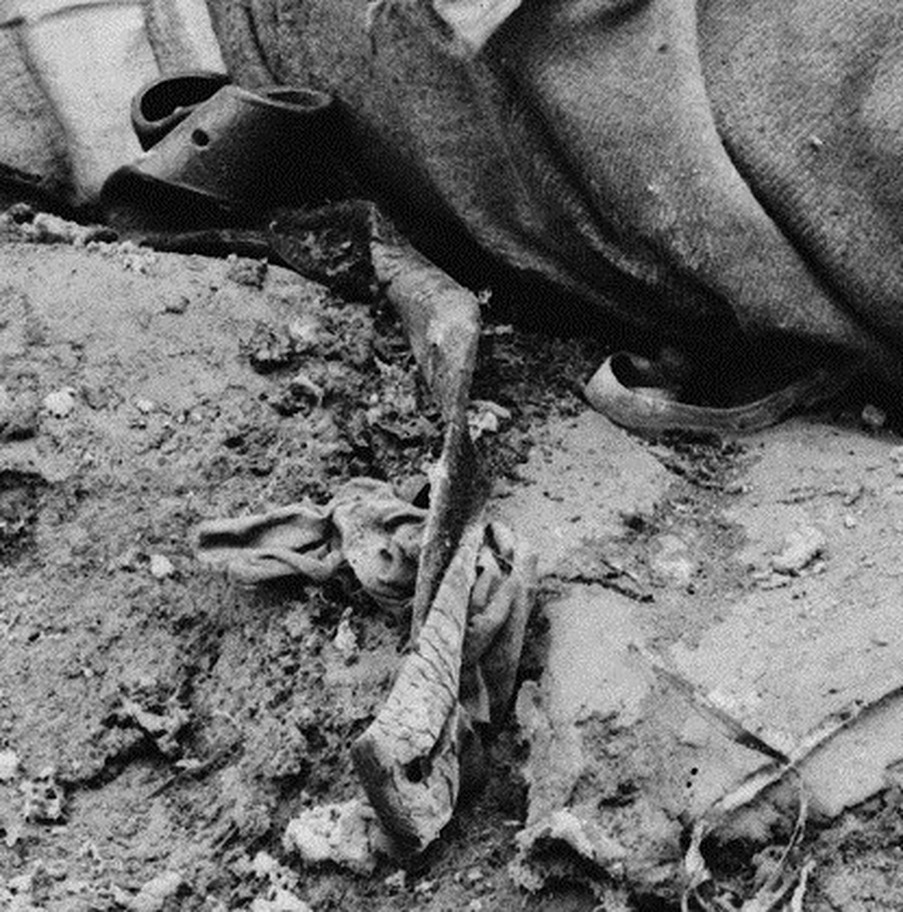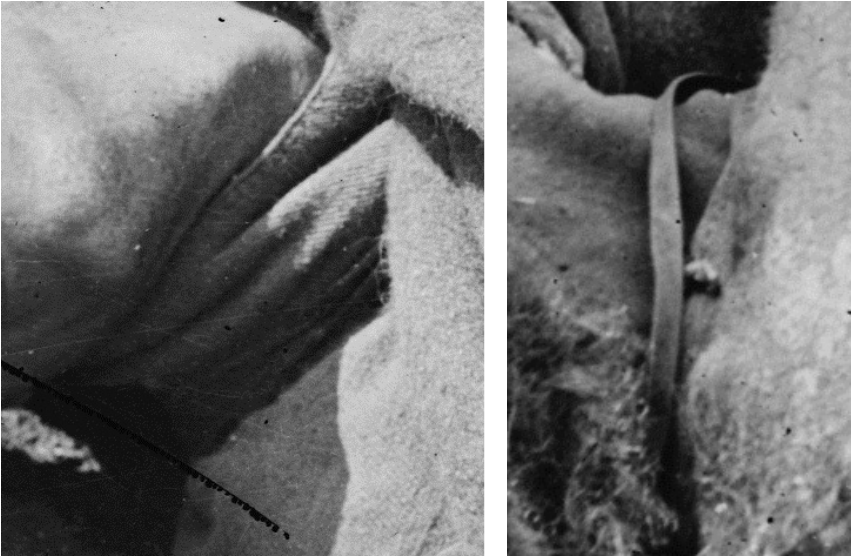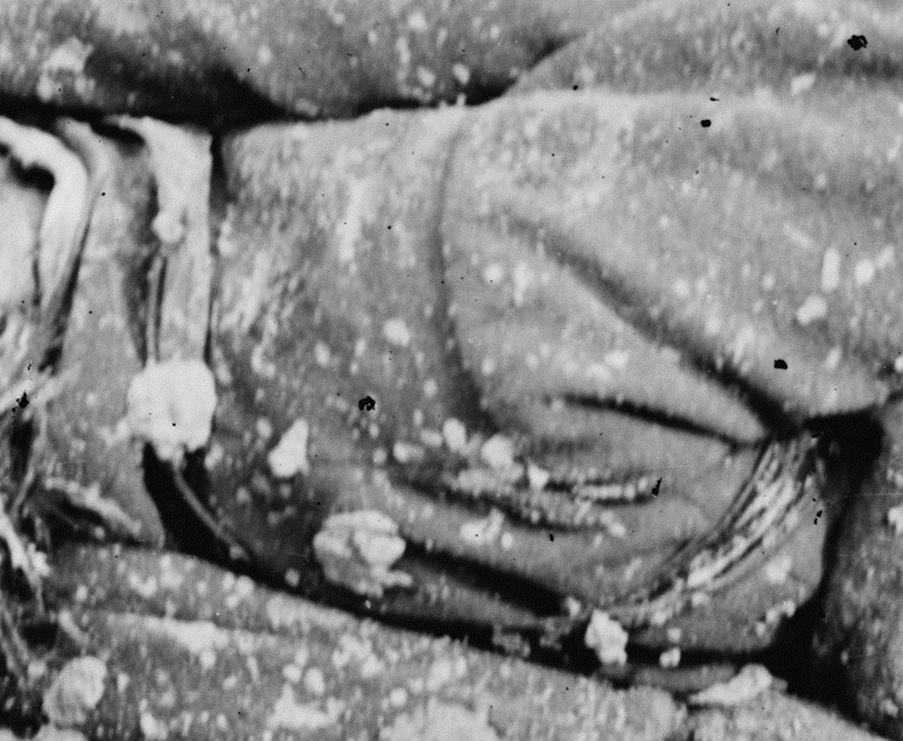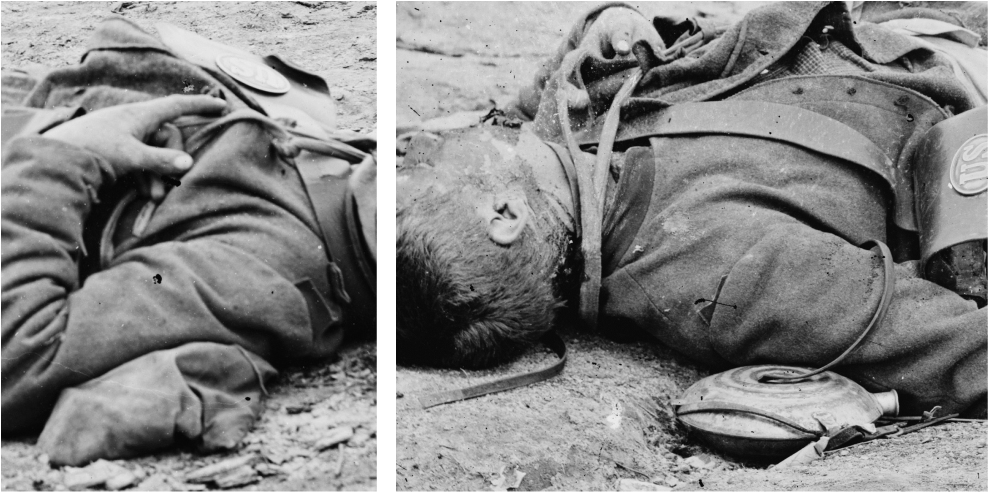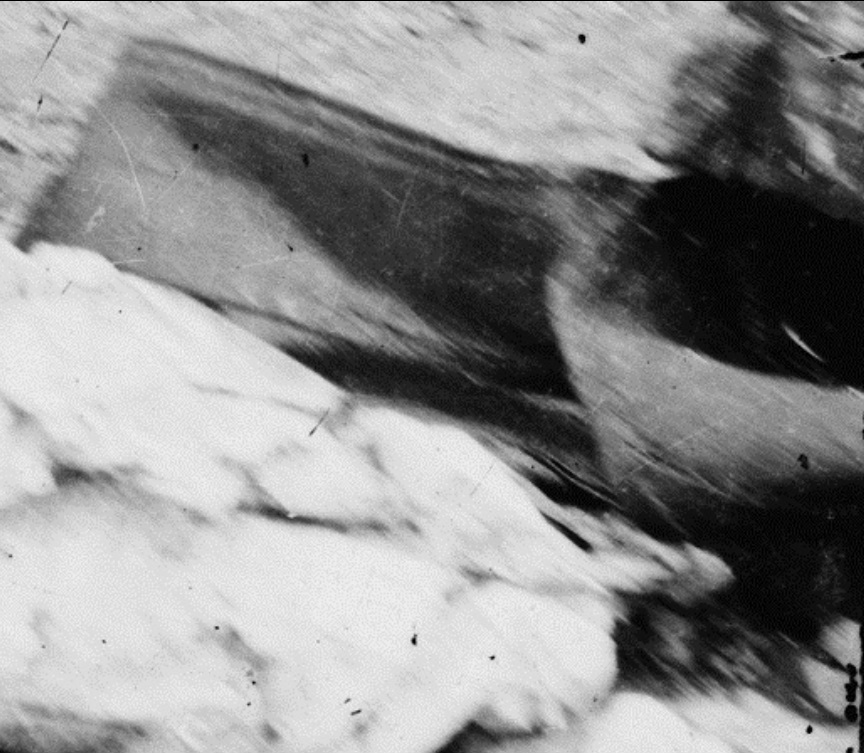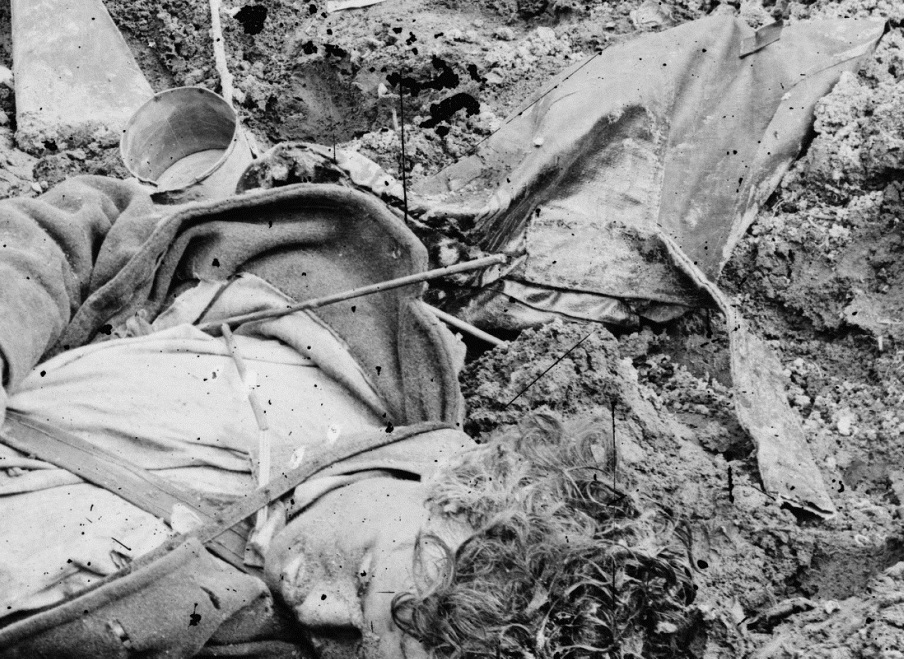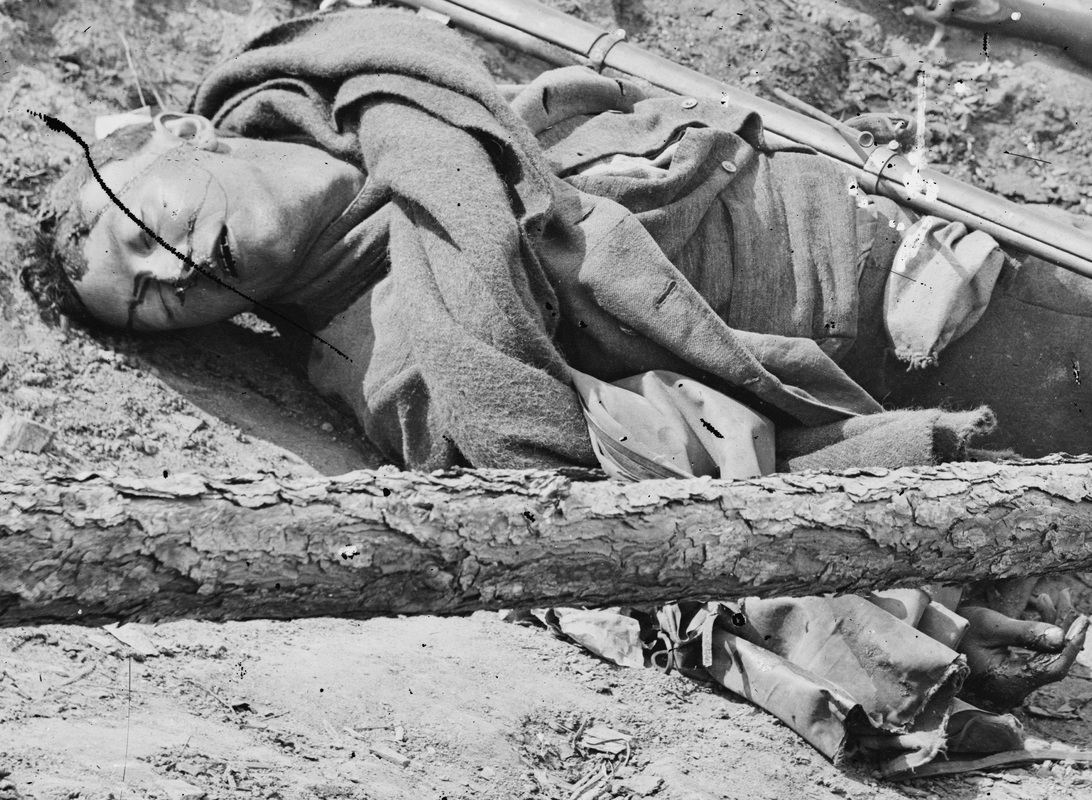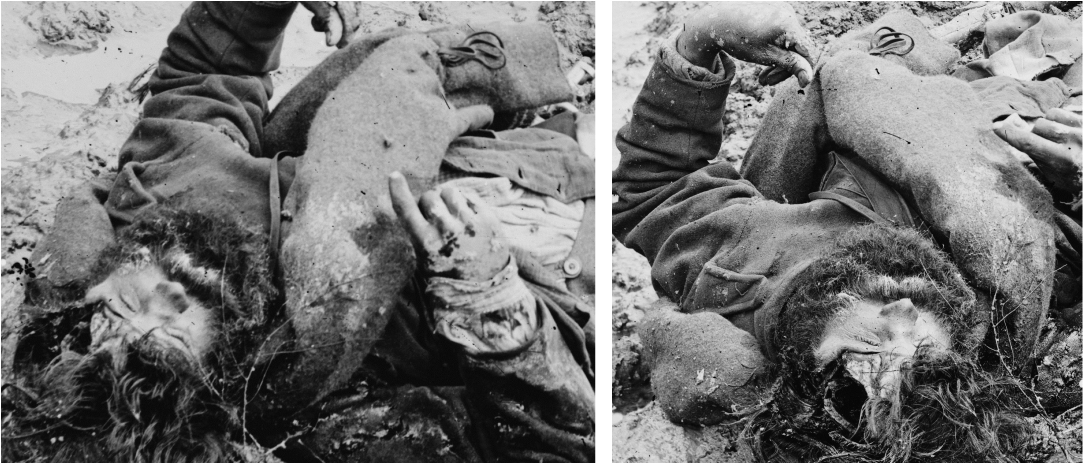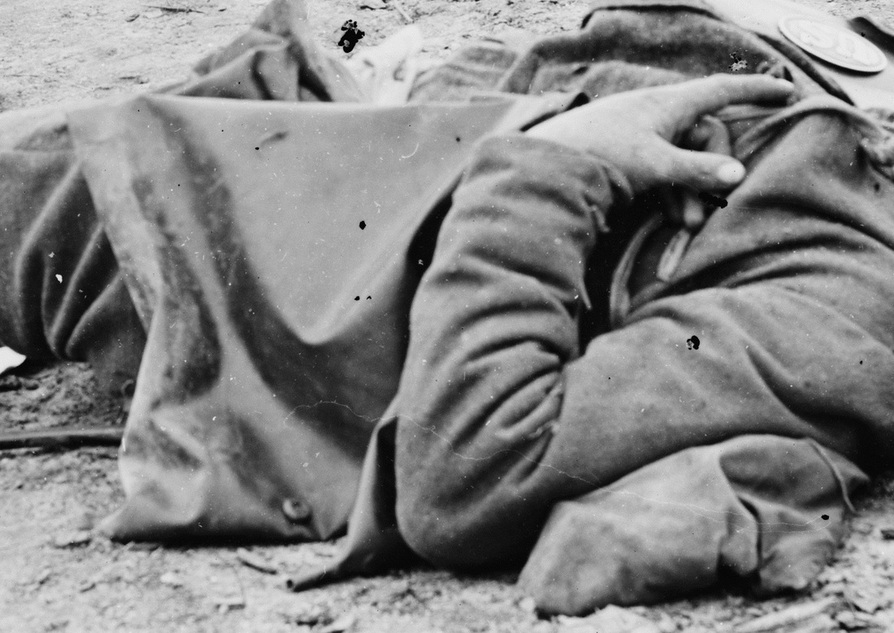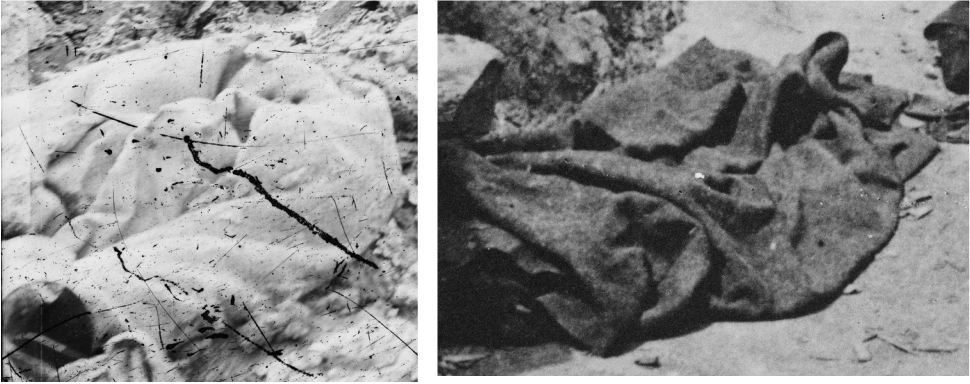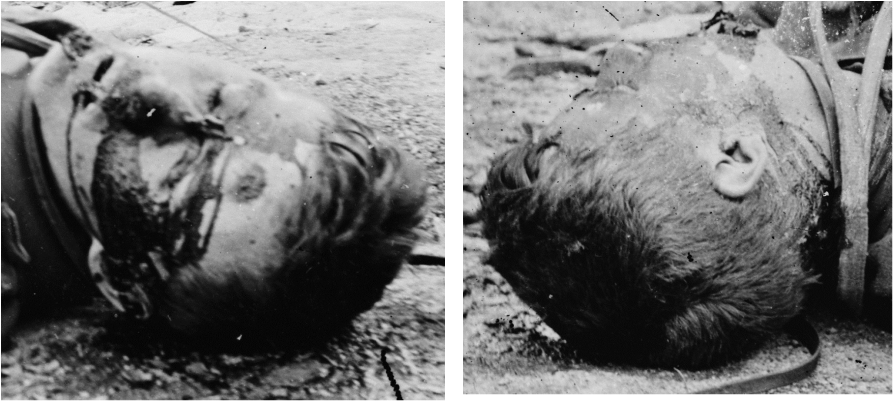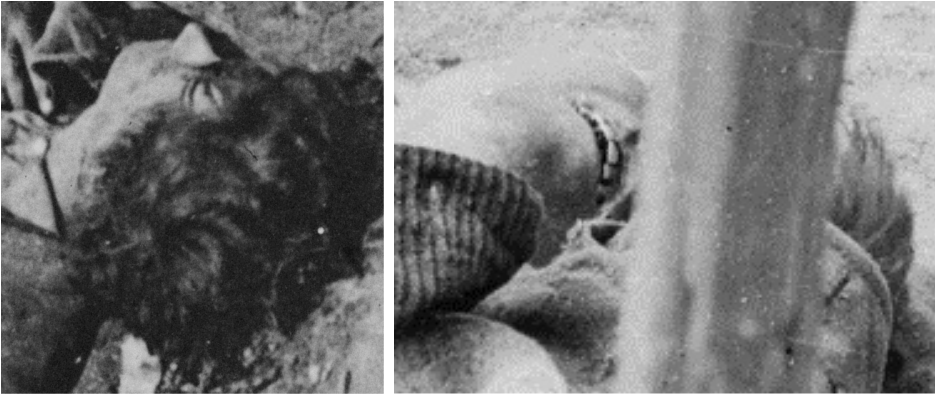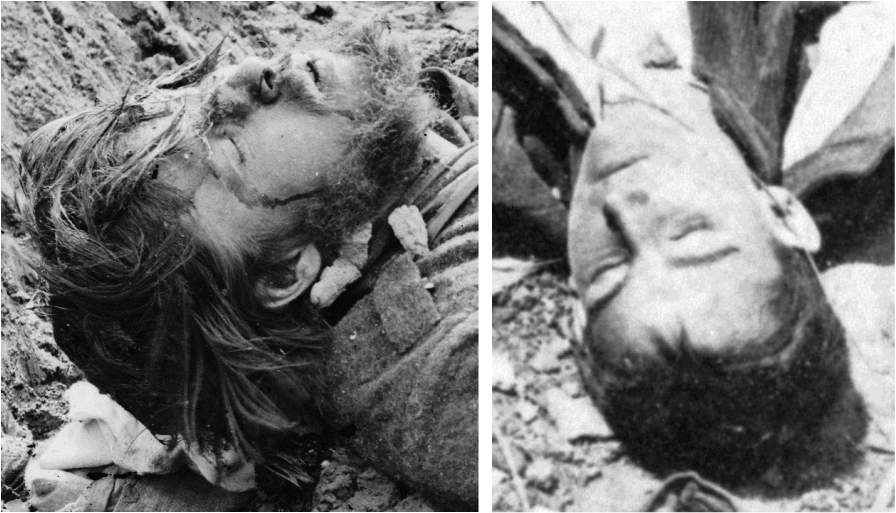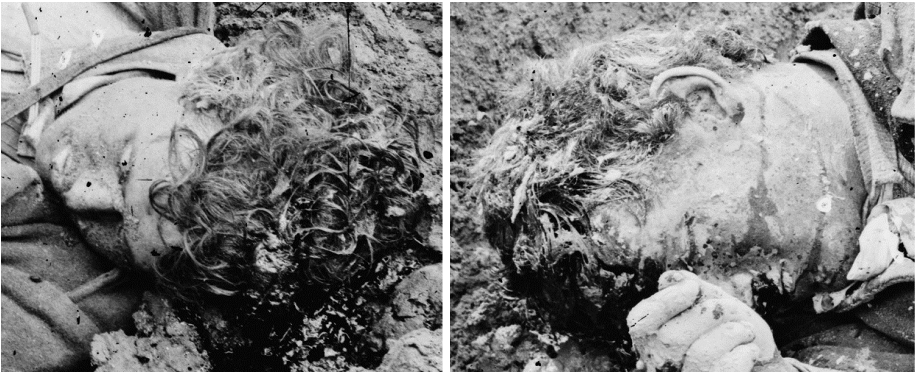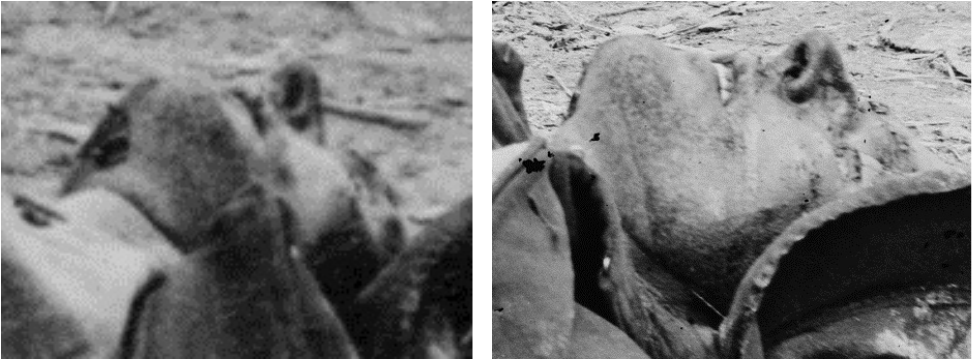|
|
|
The Confederate Soldier at Fort Mahone, Battle of Petersburg, April 2, 1865
by Fred Adolphus, 21 July 2013
The wartime photographer, Thomas C. Roche, left a profound legacy with his images taken on April 3, 1865. Roche captured a number of scenes of fallen Confederate soldiers, all of whom had perished the day before at the Battle of Petersburg, most at Fort Mahone. Roche’s intent was doubtless to document the Northerners’ victory over a prostrate South, highlighted by images of vanquished Confederate dead. More universally, Roche conveys the tragedy of war, and the waste of human life and noble spirit. He also, unwittingly provided a valuable record of the Confederate soldier’s uniform, arms and equipment in the last days of the war. It is this aspect that we turn our attention to now.
I have considered a number of factors in this study, to include jackets, pants, hats, shoes, socks, greatcoats, shirts, drawers and vests. I have also considered rifles, accoutrements, canteens, haversacks, blankets and bedrolls, and cups. Finally, I have noted the ages of the soldiers, and the grooming of their hair and beards. The purpose throughout has been to paint a picture of what the average “Johnny Reb” in Lee’s Virginia Army looked like in the closing days of the war. The comparisons include all fifteen fallen Confederate soldiers in Roche’s Petersburg images. Most of these soldiers appear to have been infantrymen, due to their accoutrements, rifles or positions in the trenches. I have assigned each of the subjects (fallen soldiers) with a number based on the last two digits of the Library of Congress number used to catalog Roche’s images. Each individual soldier is shown in pictures 1 though 15.
In completing this study, I have used images of dead men, often grotesque, to illustrate points of material culture. My intent is not to dishonor the memory of these fallen Southerners, but to awaken interest in their story and plight, and heighten appreciation for our Southern heritage.
by Fred Adolphus, 21 July 2013
The wartime photographer, Thomas C. Roche, left a profound legacy with his images taken on April 3, 1865. Roche captured a number of scenes of fallen Confederate soldiers, all of whom had perished the day before at the Battle of Petersburg, most at Fort Mahone. Roche’s intent was doubtless to document the Northerners’ victory over a prostrate South, highlighted by images of vanquished Confederate dead. More universally, Roche conveys the tragedy of war, and the waste of human life and noble spirit. He also, unwittingly provided a valuable record of the Confederate soldier’s uniform, arms and equipment in the last days of the war. It is this aspect that we turn our attention to now.
I have considered a number of factors in this study, to include jackets, pants, hats, shoes, socks, greatcoats, shirts, drawers and vests. I have also considered rifles, accoutrements, canteens, haversacks, blankets and bedrolls, and cups. Finally, I have noted the ages of the soldiers, and the grooming of their hair and beards. The purpose throughout has been to paint a picture of what the average “Johnny Reb” in Lee’s Virginia Army looked like in the closing days of the war. The comparisons include all fifteen fallen Confederate soldiers in Roche’s Petersburg images. Most of these soldiers appear to have been infantrymen, due to their accoutrements, rifles or positions in the trenches. I have assigned each of the subjects (fallen soldiers) with a number based on the last two digits of the Library of Congress number used to catalog Roche’s images. Each individual soldier is shown in pictures 1 though 15.
In completing this study, I have used images of dead men, often grotesque, to illustrate points of material culture. My intent is not to dishonor the memory of these fallen Southerners, but to awaken interest in their story and plight, and heighten appreciation for our Southern heritage.
To start with, their clothing is in excellent condition. With the exception of two soldiers, none of the items of clothing show any wear at all. This includes shoes, an article most susceptible to wear and tear. Two soldiers exhibit some minor fraying on their jacket and shirt cuffs.
The first items of clothing analyzed are the jackets and coats. Of the fifteen subjects, ten wear Richmond Depot jackets, and most of the jackets are cadet gray. Of the Richmond jackets, five appear to be cadet gray Type 2 (with shoulder straps), one coarse jeans Type 2, two cadet gray Type 3 (without shoulder straps), and two cassinet of inconclusive type. The other subjects wear different jackets. One has an imported cadet gray, Peter Tait artillery jacket with full facings and shoulder straps in red trim, another apparently has a late model, depot-issue sack coat, and one wears an undetermined type of jacket. The remaining two are double-breasted frock coats, one a light colored cassinet, and the other possibly cadet gray. All of these findings align with the contemporary documentations and surviving originals. Most Army of Northern Virginia troops did wear a cadet gray, Richmond jacket the last year of the war, some received Peter Tait, Irish-made jackets in the last months of the war, and some Virginia Army troops received four-button, short sack coats during the last phase of the war. Regarding the double-breasted frock coats, cadet gray kersey and light-colored cassinet, they may have been worn by young, company grade officers. There is no collar insignia or sleeve braid on either, but the collar rank may have been scavenged, and by the second half of the war, company officers were authorized to omit sleeve braid on their field uniforms, so there may not have been any to begin with. It is possible that one or both of the double-breasted frocks were privately purchased enlisted coats. After all, Confederate regulations authorized enlisted soldiers to wear a double-breasted tunic. Surviving double-breasted enlisted frocks dating from the end of the war indicate that a small number of troops managed to acquire and wear such coats.
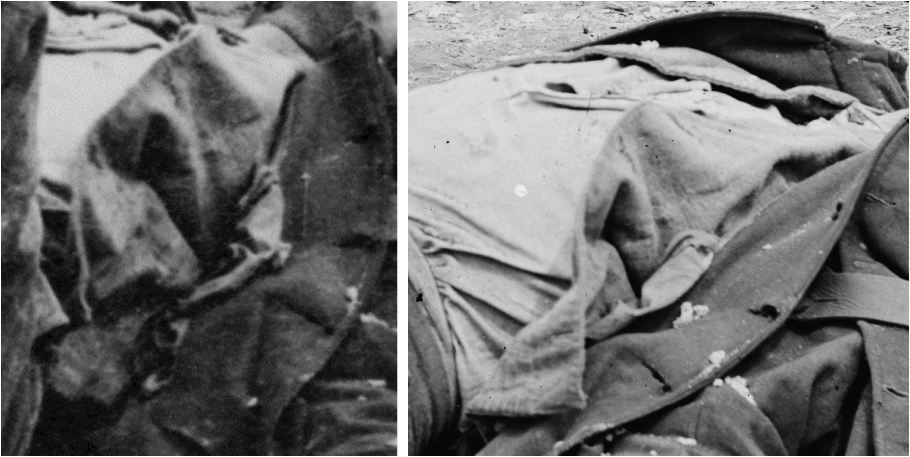
Pictures 37-38: Soldier 86 appears to wear a late-war Richmond Depot sack coat. While the garment is somewhat obscured, there are some clues to support this idea. The fabric is flimsy and of domestic weave, as are the surviving originals. The bottom corners are squared and the buttonholes are widely spaced. There appear to be no more than four buttonholes: a typical sack coat characteristic.
We
can surmise the types of buttons worn on nine of the jackets and coats. Souvenir hunters scavenged the buttons off of
four of the jackets, while the buttons on at least two jackets remain intact. One jacket has had its front buttons removed,
while the Federal eagle cuff buttons were left on the jacket. It appears, in each case, that the buttons
left intact were Federal, and therefore were undesirable to collect. One of the Richmond jackets with its buttons
intact has Federal eagle “I” buttons. Assuming
that the scavenged jackets had desirable Confederate buttons, we can surmise
that five jackets had Confederate buttons.
All of the trousers, except for one, show signs of scavenging: pockets pulled out or cut open, and flies opened. This provides a unique opportunity to examine the linings, pockets, buttons and waistbands of the subjects’ pants.
Seven of the pants were kersey, three were jeans, two were cassinet, one was a salt-and-pepper plain weave, and one was undetermined. The kersey trousers appear to have been cadet gray, and had “V” pocket openings with buttonholes on the flaps. One of the kersey pants may possibly have side seam openings, but the pocket is not fully visible. The jeans colors appear to vary and the pocket type is inconclusive, while the cassinet trousers are of a light shade. One pair of the cassinet trousers has the same style of pockets as the kersey pants: “V” shaped pocket openings with buttonholes. The other pair of cassinet pants has side seam pocket openings. The plain weave pants may be homemade or citizen trousers. Buttons consisted of stamped, japanned tin, horn, bone and wooden types. The linings were all white cotton osnaburg, with the exception of one pair of kersey pants, which had darker linings. One pair of the cassinet trousers has a small wooden, W.C. Allen button on the fly. All of the trousers appear to have been military issue except for the salt-and-pepper plain weave pants.
Seven of the pants were kersey, three were jeans, two were cassinet, one was a salt-and-pepper plain weave, and one was undetermined. The kersey trousers appear to have been cadet gray, and had “V” pocket openings with buttonholes on the flaps. One of the kersey pants may possibly have side seam openings, but the pocket is not fully visible. The jeans colors appear to vary and the pocket type is inconclusive, while the cassinet trousers are of a light shade. One pair of the cassinet trousers has the same style of pockets as the kersey pants: “V” shaped pocket openings with buttonholes. The other pair of cassinet pants has side seam pocket openings. The plain weave pants may be homemade or citizen trousers. Buttons consisted of stamped, japanned tin, horn, bone and wooden types. The linings were all white cotton osnaburg, with the exception of one pair of kersey pants, which had darker linings. One pair of the cassinet trousers has a small wooden, W.C. Allen button on the fly. All of the trousers appear to have been military issue except for the salt-and-pepper plain weave pants.
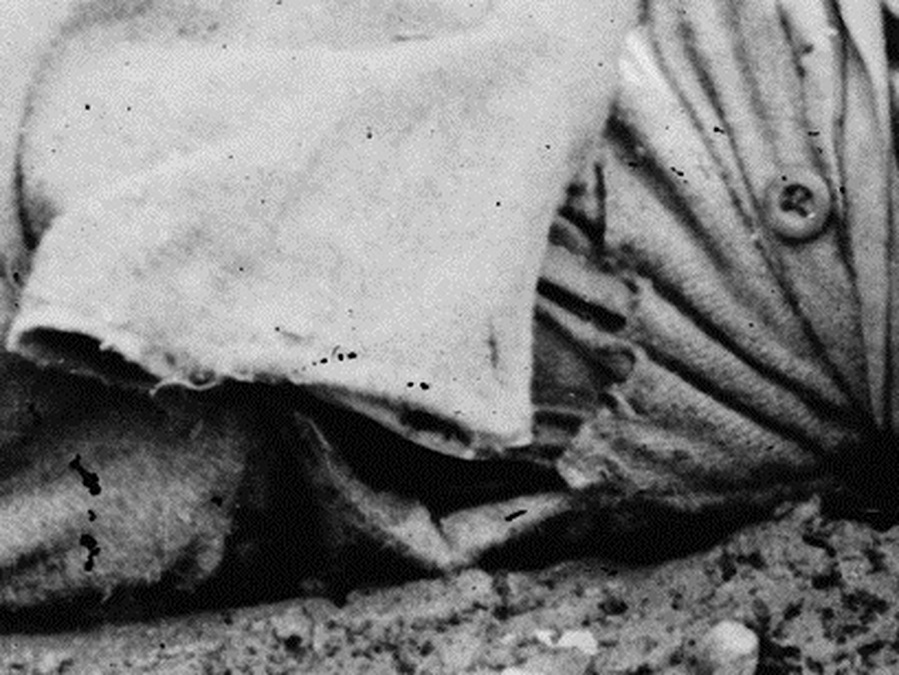
Pictures 57-58: The two above images of Soldier 89 offer another view of cassinet pants. In this case, the pockets have the "V" openings with buttonholes frequently observed on Richmond pants. The linings are the tyupical unbleached osnaburg. The visible fly button is the small, Confederate issue, wooden button, known to have been manufactured by W.C. Allen of Prattville, Alabama.
The following conclusions can be drawn regarding the combinations of jackets and pants, soldier-by-soldier, allowing for some guesses on two or three garments: five soldiers had cadet gray jackets and pants; four had cadet gray jackets and jeans, cassinet or plain fabric pants; one had a cassinet jacket and cadet gray pants; two had jeans jackets and pants; and, two had double-breasted frock coats and cadet gray pants.
There are eight hats pictured near the subjects. All of the hats, except for one, are black wool felt, suggesting British imports. They appear to be similar. Three hats have a narrow black band and black grosgrain edging around the brim, another has only a narrow black band, and another has only black brim edging. All of the hats are misshapen, but in good condition. Soldier 85 has a hat that may differ in color and origin, but the images are too indistinct to draw conclusions. A Union forage cap lays near another soldier that may have been dropped by a Union soldier after the attack. This evidence suggests that Lee’s army was well supplied with black, wool felt, British import hats and that few troops wore caps.
There are eight hats pictured near the subjects. All of the hats, except for one, are black wool felt, suggesting British imports. They appear to be similar. Three hats have a narrow black band and black grosgrain edging around the brim, another has only a narrow black band, and another has only black brim edging. All of the hats are misshapen, but in good condition. Soldier 85 has a hat that may differ in color and origin, but the images are too indistinct to draw conclusions. A Union forage cap lays near another soldier that may have been dropped by a Union soldier after the attack. This evidence suggests that Lee’s army was well supplied with black, wool felt, British import hats and that few troops wore caps.
The subjects wore white osnaburg and colored, patterned shirts in roughly equal proportions. Of those that could be discerned, there were six white osnaburg shirts, three finely checked shirts, one finely striped shirt, and one heavy weight, dark corduroy shirt with a horizontal grain and two breast pockets. The checked shirts were varied from light to colorful to dark. Three of the shirts are clearly worn tucked into the drawers, suggesting that this was how most soldiers wore their shirts. One shirt was worn with a light colored neck tie. All of the five visible pairs of drawers were white osnaburg. Three of these exhibited a light bone button at waistband.
A close study of the subjects’ shoes revealed some interesting conclusions. Twelve pair (which includes shoes laying to the side, unworn) are standard height "bootees," to use a period term, although contemporary Confederate records referred to them almost exclusively as "shoes." Of these, one pair has metal eyelets, one pair has the heel pieces on the outside, and four pair have the heel pieces on the inside (one of these pair exhibits a double row of wooden pegs on the soles). More remarkable are two pair of high top "Jefferson" bootees with the heel pieces on the inside. These are about ten inches high and both soldiers wearing them had tucked their pant legs into them, much like modern combat boots. Judging by the differences in the examined shoes (heel piece construction, metal and unlined eyelets, numbers of eyelets, and the high top boots) suggests that the Army of Northern Virginia used a variety of footwear. Some of these shoes may have been imported.
Some other observations offer insights into how soldiers wore their shoes. Four had their pant legs tucked into their socks, one had his pant cuffs folded up outside the socks, and eight had the pant legs worn outside the socks (not tucked inside). Two soldiers were bare footed, or partially bare footed. Souvenir hunters may have taken these soldiers’ shoes, as there appears to have been no shortage of good footwear among the fallen. The shoelaces of one pair of shoes are visible, and have been cross-laced (in the American style), rather than bar-laced (in the European style). As mentioned before, the shoes are all in excellent condition, to include at least one unissued pair, and one pair so recently issued that the wooden pegs are not worn down. Last of all, the six pairs of visible socks all appear to be drab white in color. The socks may represent imported British socks, as almost all army issue socks were imported British manufactures.
Some other observations offer insights into how soldiers wore their shoes. Four had their pant legs tucked into their socks, one had his pant cuffs folded up outside the socks, and eight had the pant legs worn outside the socks (not tucked inside). Two soldiers were bare footed, or partially bare footed. Souvenir hunters may have taken these soldiers’ shoes, as there appears to have been no shortage of good footwear among the fallen. The shoelaces of one pair of shoes are visible, and have been cross-laced (in the American style), rather than bar-laced (in the European style). As mentioned before, the shoes are all in excellent condition, to include at least one unissued pair, and one pair so recently issued that the wooden pegs are not worn down. Last of all, the six pairs of visible socks all appear to be drab white in color. The socks may represent imported British socks, as almost all army issue socks were imported British manufactures.
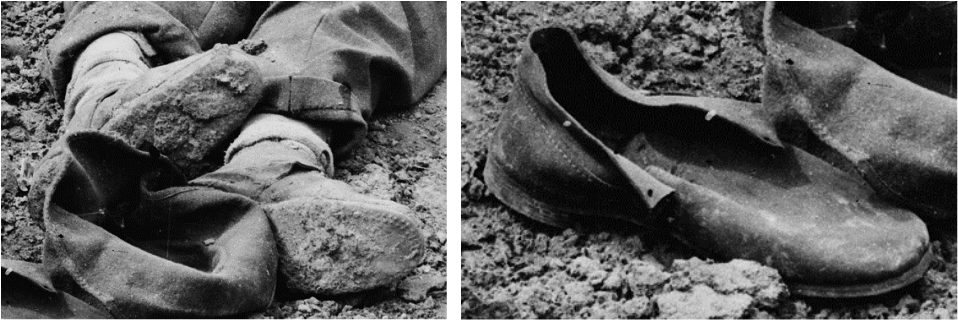
Pictures 97-98: Soldier 83b wears typical army shoes (left image) with double-rows of pegs on the soles. The shoes are so new that the pegs are not even worn flat. Additionally, an unworn, new shoe lies next to Soldier 83b (right image). It has two eyelets on either side, and the heel piece is on the outside. It also appears that Soldier 83b rolled his pant cuffs up. He also wears white wool socks. David Jarnagin pointed out that pegged shoes were a wartime expediency. Better quality shoes always had sewn soles.

Pictures 101-102: Soldier 89 (left image) has the usual army shoes with three eyelets on each side. His shoes are cross-laces, and the pant legs are tucked into his socks. Likewise, one of Soldier 87's pant legs is tucked into his sock (right image). Soldier 87 appears to have had his shoes and one sock scavenged from his feet. Both soldiers have white wool socks.
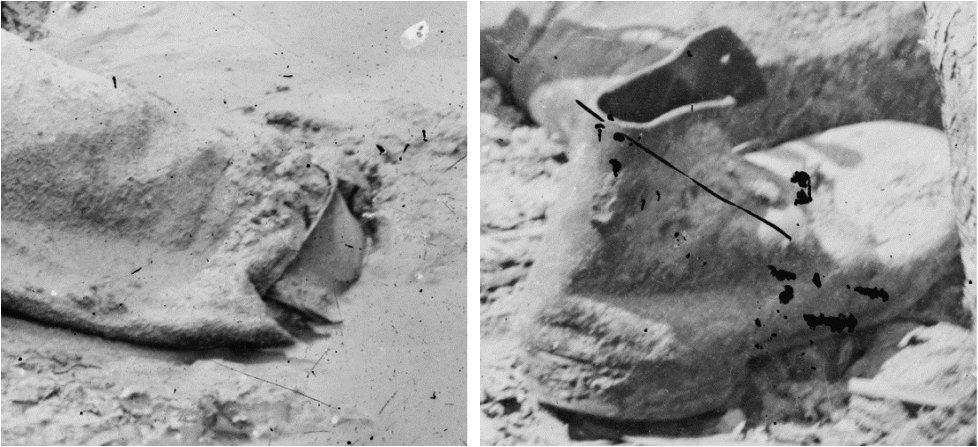
Pictures 105-106: Soldier 90 (left) also wears a pair of high-top, Jefferson bootees with his pant legs tucked into the tops. The loose shoe pictured beside Soldier 75 (right) also appears to be the high-top style. It is similar to that worn by Soldier 84 and has only two eyelets, as well. This style of bootee had been in use since the early nineteenth century.
Of fourteen subjects, six clearly wore vests, six did not, and the rest were inconclusive. Four of the vests were military style. One of the military vests is medium dark colored jeans, with bottom pockets and a pocket at the left breast. Its buttons appear to have been scavenged.
The next vest, also military cut and probably black in color, is made of jeans or satinet with small military brass buttons intact, and eight visible buttonholes. The next military vest is of jeans, with cotton tape sewn along the edge of the left lapel and to the left of the buttonholes. The buttons are not visible. The last military vest is medium dark corduroy, with a vertical grain, and medium-colored horn buttons. The only citizen style vest is of medium light-colored jeans, and is double-breasted. It has unjapanned, stamped metal trouser buttons, and a lower pocket visible on the right side. The last vest is of an undetermined style, made of jeans with a lower pocket on each side. All vests are in excellent condition, except that the cotton tape on the one military vest is slightly frayed. Finally, two of the soldiers had knitted woolen scarves, a further indication that the weather was chilly on the morning of the battle.
The next vest, also military cut and probably black in color, is made of jeans or satinet with small military brass buttons intact, and eight visible buttonholes. The next military vest is of jeans, with cotton tape sewn along the edge of the left lapel and to the left of the buttonholes. The buttons are not visible. The last military vest is medium dark corduroy, with a vertical grain, and medium-colored horn buttons. The only citizen style vest is of medium light-colored jeans, and is double-breasted. It has unjapanned, stamped metal trouser buttons, and a lower pocket visible on the right side. The last vest is of an undetermined style, made of jeans with a lower pocket on each side. All vests are in excellent condition, except that the cotton tape on the one military vest is slightly frayed. Finally, two of the soldiers had knitted woolen scarves, a further indication that the weather was chilly on the morning of the battle.
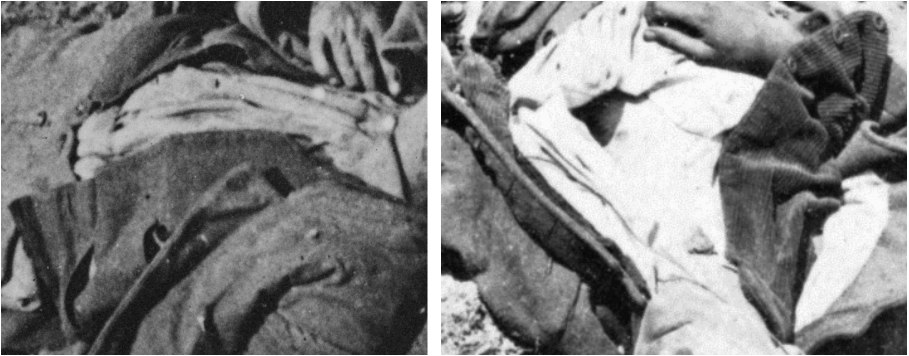
Pictures 111-112: Soldier 82f (left) has a medium-dark colored jeans, military style vest with bottom pockets and a pocket at the left breast. The buttons appear to have been scavenged. Soldier 87 (right) wears a military cut vest of medium-dark corduroy material with a vertical grain, and medium colored, horn buttons.
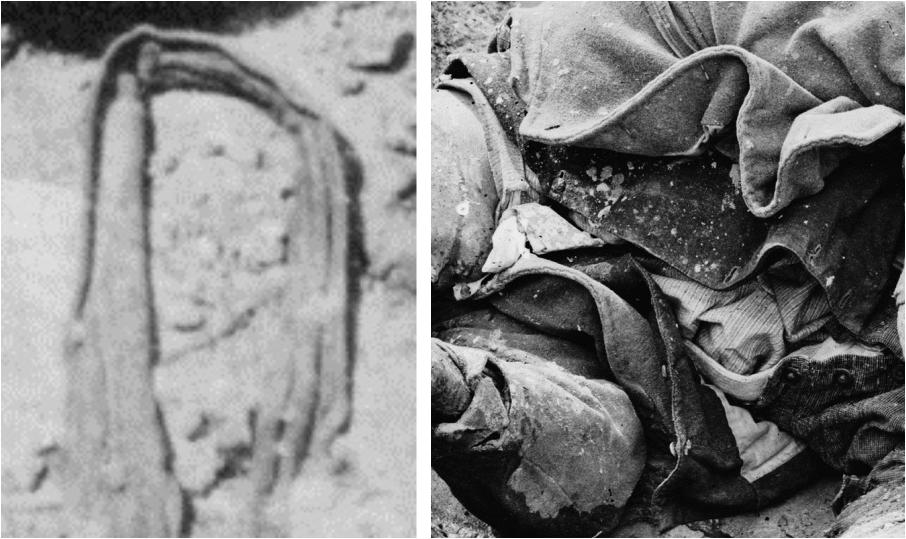
Pictures 113-114: The left image shows Soldier 87's scarf, another critical piece of cold-weather clothing. Soldier 90, on the right, has a dark, black jeans cloth, or satinet, military style vest with small military, brass buttons (intact), and eight visible buttonholes. His knitted, white wool scarf is visible under his vest, tucked into his pants.
Only
two soldiers wore greatcoats. Both are
in excellent condition, and appear to be captured Union infantry greatcoats. They are made of kersey, and have standing
collars with box-shaped, machine stitching inside the collars. One displays a six-button cape, the front of
the coat has at least five button holes, and the sleeves are two-piece but
without French cuffs. No collar hooks
are visible on the right side. The other
coat displays French cuffs, two-piece sleeves, and two collar hooks are visible
inside the collar. All of these traits
are common to the Union “foot service” greatcoat that was made both with and
without French cuffs.
Most of Roche’s subjects appear to have been infantrymen, although one was apparently an artillerymen. The artilleryman, Soldier 80 with a red-trimmed Peter Tait-style jacket, was accoutered as an infantryman. He was probably one of the heavy artillerymen who was hastily converted to infantry when they abandoned their guns. There are eight visible rifles in the images, but most were moved around, and at least one was used as a prop by two different fallen men, reducing the total to seven. This makes it difficult to draw conclusions about the men's small arms. Four are US M1861 rifle muskets, one of which is an M1861 Colt Special, and one of which may be an M1855. Two of the four have Confederate canvas slings attached to their middle bands. There are two P53 Enfield rifle muskets visible, one of which has the muzzle shot away, and appears as a prop by two different fallen soldiers. The undamaged Enfield has a leather sling attached to the front band. An ammunition crate in one of the images marked, “1000 CARTRIDGES FOR RIFLE MUSKET CAL: .574 INCH,” conforms to the caliber used with the Enfield rifles. The last visible rifle, a two-bander with a mangled muzzle, is identified as a Liège pattern Minié rifle.
The images also reveal something of the fighting. One bayonet is prominent near one of the fallen, having been stuck into the side of the trench to hold a ramrod. Three of the images depict cartridge papers and packet paper scattered about the ground, indicative of heavy fighting. Apparently, one of the positions has two package wrappers and eight or nine cartridge papers, a second position has one package wrapper and about seven or eight loose cartridges and papers, a third position has one package wrapper and three or four cartridge papers, and the last position has one or two package wrappers and about twenty-one cartridge papers. One image indicates that the fighting positions were spaces no less than six feet apart, indicating that Lee’s trenches were thinly manned.
The images also reveal something of the fighting. One bayonet is prominent near one of the fallen, having been stuck into the side of the trench to hold a ramrod. Three of the images depict cartridge papers and packet paper scattered about the ground, indicative of heavy fighting. Apparently, one of the positions has two package wrappers and eight or nine cartridge papers, a second position has one package wrapper and about seven or eight loose cartridges and papers, a third position has one package wrapper and three or four cartridge papers, and the last position has one or two package wrappers and about twenty-one cartridge papers. One image indicates that the fighting positions were spaces no less than six feet apart, indicating that Lee’s trenches were thinly manned.

Pictures 118: One of the two rifles laying near Soldier 75: a Colt Special M1861 contract rifle musket. It has a Confederate, canvas sling attached to middle band and trigger guard. Dr. Michael R. Cunningham has also noted that it carries an M1861 Springfield or CS Richmond flat, middle barrel band, suggesting that it was refurbished in a Southern arsenal.

Pictures 119: The second rifle laying near Soldier 75 has has been mangled by a bullet or shrapnel. According to Civil War small arms expert, Kevin Dally, it is a Liège pattern Minié rifle, also called
the Belgian rifle of Enfield pattern. The O.P. Drissen Company in Liège,
Belgium manufactured this rifle which combined features of the British
Pattern 1856, Enfield short rifle, and the French Light Minié rifle. It was a .577 caliber rifle that mounted a straight bladed saber bayonet. US purchasing agents imported approximately 6,000 of these rifles. Collectors refer to it as the “Brazilian Light Minié Rifle” based on evidence that the Belgians originally made these weapons for the Brazilian military, but sold them to US buyers instead.
Five of the fallen soldiers exhibit infantry accoutrements. Three leather waist belts are visible, but only one buckle is visible: it is the quintessential Confederate iron roller buckle. Four leather cartridge boxes are evident, one of them is clearly Federal and still retains a “US” box plate on the flap. This box was worn by an artilleryman, who also had a Federal bayonet scabbard with his accoutrement set. Three of the boxes included cartridge box belts (usually called “slings” today). One cartridge box belt is Confederate-made, machine-stitched, white cloth, and appears to have been cut away from its accompanying cartridge box. Its box also appears to be looped through the waist belt (with the roller buckle). There is a single loop, Confederate cap pouch on the roller buckle belt, as well.
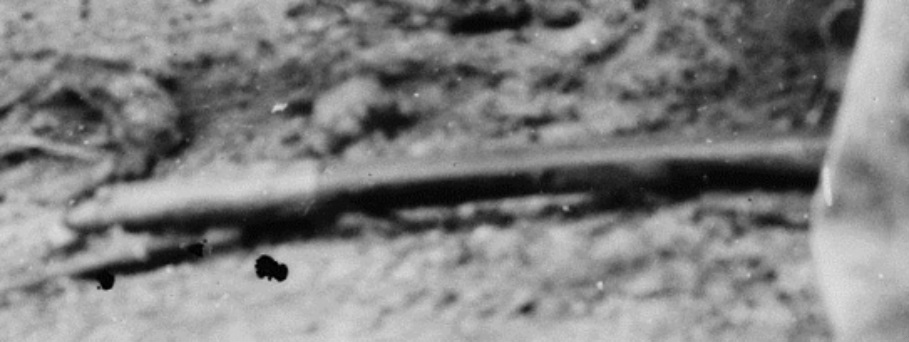
Pictures 133-134: The two above perspectives of Soldier 80 indicate that he used captured Federal accoutrements. These included a cartridge box with a cartridge box plate; a cartridge box belt ("sling") without a cartridge box belt plate; and, a bayonet scabbard. The waist belt, and its buckle or plate, are not visible.
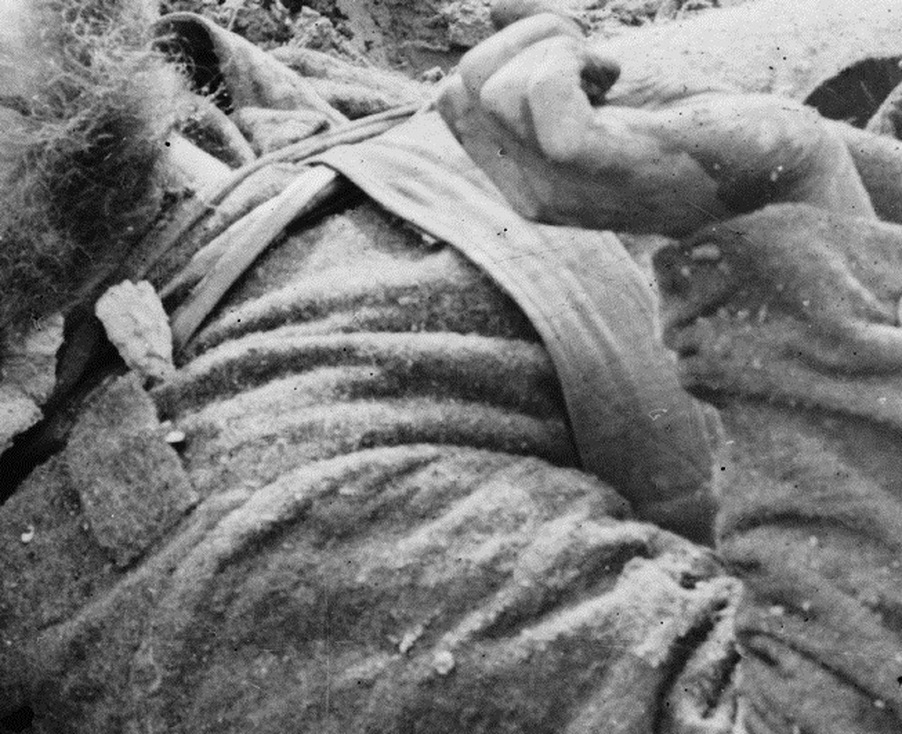
Pictures 136: Another view of Soldier 84 offers more clues about his accoutrements. He had white cloth cartridge box belt (sling) over his left shoulder. It is machine-stitched with two rows in a serpentine pattern. It is possible that scavengers cut it away from the cartridge box (on the waist belt) to facilitate their plundering.
Five
haversacks are visible in the photos: two are enameled Federal and three may be
Confederate. All of them have been
ransacked. More haversack straps are
visible than satchels. Six images show
haversack straps worn over the right shoulder with the satchel worn at the left
hip, and only one carried his haversack over his left shoulder. There are four visible black enameled cloth
straps (one clearly belonging to a Federal satchel), one non-enameled strap with
an enameled, non-gusseted satchel at the left hip, and one non-enameled strap attached
to a non-enameled, non-gusseted satchel on the left hip. Another enameled Federal haversack lays next to
the left of a fallen soldier. The one
haversack worn over the left shoulder has an enameled strap with the enameled,
gusseted satchel cut away and laying at the soldier’s right side. Evidently, the fallen soldiers used two
captured Federal haversacks, and three Confederate manufactured haversacks.
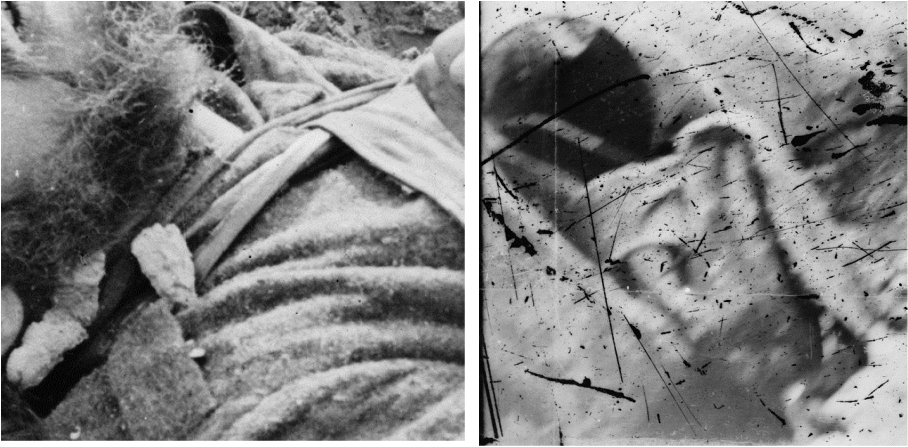
Pictures 143-144: Two perspectives of Soldier 84 indicate that he had three straps over his right shoulder, one of which was a Federal enameled haversack strap. Tossed off to the soldier's right side are a blanket roll and Federal haversack satchel, apparently removed from the body to facilitate plundering. Aside from the haversack strap, the other two appear to be a thin leather, Confederate canteen strap, and a white cloth, Federal canteen strap.
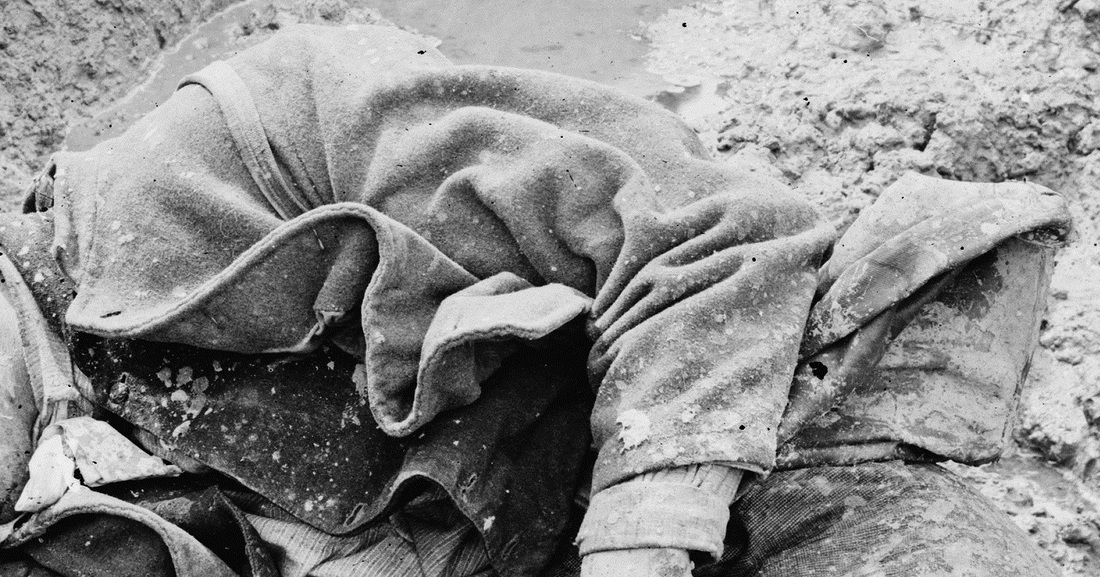
Pictures 149: Soldier 90 has a narrow, non-enameled haversack strap seen at his left shoulder, although it appears that looters have pulled it over his head from his right shoulder to plunder his clothing. The strap is attached to a non-enameled satchel at his left hip. The haversack appears to be of Confederate manufacture.
The images indicate that all of the soldiers wore their canteens over the right shoulder. Most of the canteens employed a narrow leather strap. Four narrow leather canteen straps are visible, as well as two cloth Federal straps. The only canteens visible are two captured Federal ones, doubtless because any Confederate canteens had been snatched up by souvenir scavengers before the images were made. Nonetheless, the leather Confederate slings suggest a general usage of Confederate canteens. Regarding the captured Union canteens, one, on the ground nearby, has a cassinet cover, commonly used by Federal manufacturers. The other, a bulls-eye canteen without a cover, has a thin leather sling that has been cut, and includes a small “D” buckle. In addition to the canteens, two cups are visible in the images.
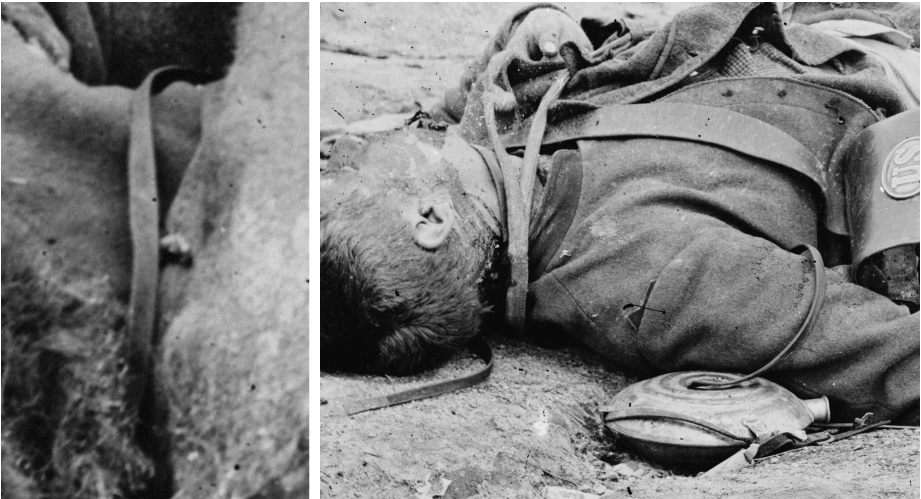
Pictures 150-151: Soldiers 77 (left) and 80 (right) both have thin leather canteen straps over their right shoulders. Soldier 80 carried a captured Federal, bulls eye canteen with the cover removed. His strap has a small "D" buckle and appears to be Confederate. Looters have cut the strap to ease their plundering.
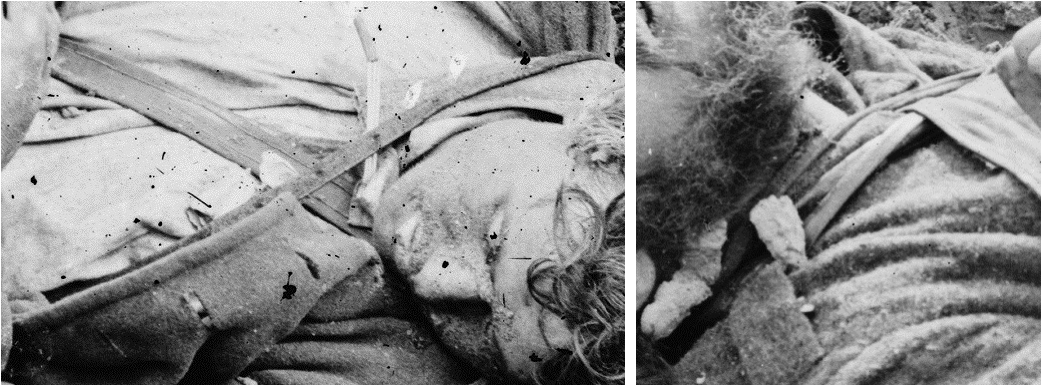
Pictures 152-153: Both Soldier 89 (left) and 84 (right) have thin leather, Confederate style canteen straps over their right shoulders. Soldier 89's canteen strap has be cut off in front, indicating that a souvenir hunter took a Confederate drum-style canteen from his body. Soldier 84 had a cotton Federal canteen strap, in addition to the leather Confederate canteen strap, which might indicate that he carried two canteens, one of them Federal.
Some of the soldiers have woolen blankets and gum blankets. Three wear woolen blanket bedrolls. Two of these are rolled without a twist, and one with a twist. Two are carried over the left shoulder, and one over the right shoulder. All three are tied only at the bottom with a single lace. One of the blanket rolls has dark colored end stripes. There is also a dark colored blanket on the ground near one of the fallen soldiers, and a light colored bedroll laying to the right of another. It is difficult to gauge the blankets’ colors in the black and white images, but they are most likely imported British, that came in white, blue-gray or brown-gray colors.
Two of the fallen soldiers display rubber blankets, probably captured Federal. One of the rubber blankets is carried as a separate roll over the left shoulder (the same shoulder as the soldier’s bedroll), and one is carried folded over the haversack strap. Evidently, soldiers carried their gum blankets in a manner that made them readily accessible without having to take them off the bedroll.
Two of the fallen soldiers display rubber blankets, probably captured Federal. One of the rubber blankets is carried as a separate roll over the left shoulder (the same shoulder as the soldier’s bedroll), and one is carried folded over the haversack strap. Evidently, soldiers carried their gum blankets in a manner that made them readily accessible without having to take them off the bedroll.
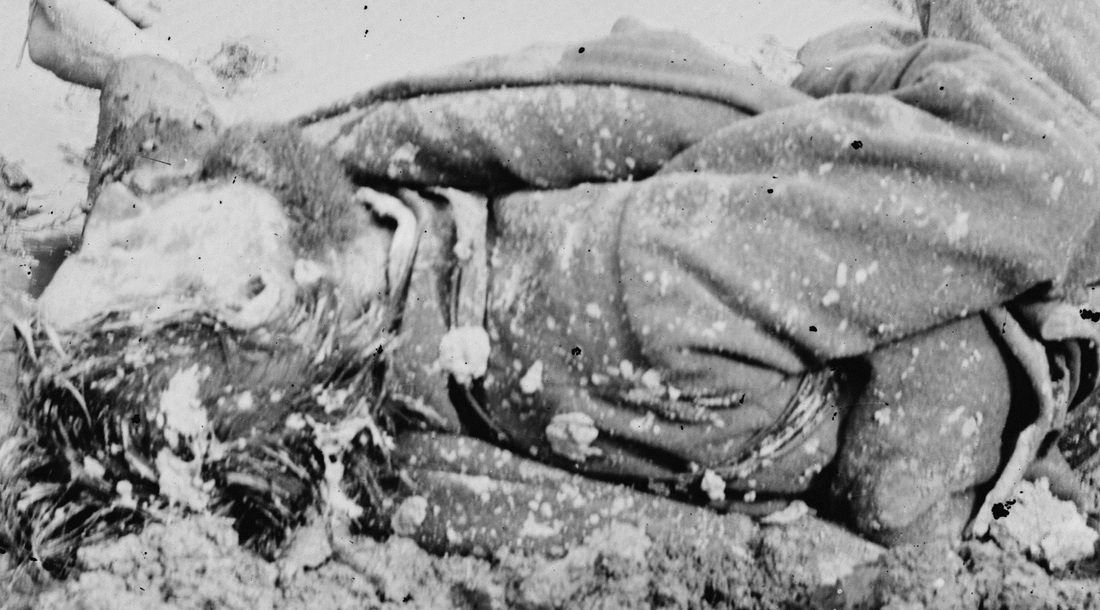
Pictures 161: Soldier 79 wore his blanket bedroll over his left shoulder. He rolled it without a twist and tied it only at the bottom. Judging from the shading of the colors, the blanket appears to be cadet gray, which would have been the most common blanket color used by the Confederate army at that time: the blankets being imported from England and having the same color as the imported uniform cloth.
Aside from the fallen soldiers’ uniforms and equipment, the images offer insights into their hairstyles, ages, body build, and type of hair. None of the men wore their hair long: it did not fall very much below the collar or over the ears. Three had thick, full hair and beards, but these were fairly short: the beards not much more than an inch in length. One had thick, full hair, but maintained a close cropped beard of only a quarter inch long. Three had thick, full hair, and were without facial hair. Another, whose hair was not visible had a few days growth of stubble. Four had no facial hair, except for one with a thin mustache, and their hair was cropped short. There are no stylized mustaches, goatees, side whiskers or long beards. Some of the soldiers were apparently too young to have grown a beard. The soldiers’ hair and beards reflect the preferences of the late war period. The practicality and comfort of short hair and full beards, or being clean shaven, had replaced earlier preferences long hair and carefully tended goatees. Long hair was difficult to keep clean and free of lice in the trenches, and soldiers increasingly cropped their hair close to the scalp to mitigate the troublesome vermin.
Regarding the soldiers’ ages six appear to have been in their twenties, four in their late teens, one about thirty, and one is reputed to have been fourteen years old. Some of the soldiers’ faces were not visible and thus yielded inconclusive results. As for the soldiers’ other physical attributes, all appear to have been trim, none showing any signs of having been overweight. All were clearly of Anglo-Saxon ethnicity, judging from their facial features and hair. Their hair type ranges fairly evenly from curly to wavy to straight, and their hair color is about evenly divided between auburn, medium-brown or auburn-brown, and blond, sandy or sandy-blond.
Regarding the soldiers’ ages six appear to have been in their twenties, four in their late teens, one about thirty, and one is reputed to have been fourteen years old. Some of the soldiers’ faces were not visible and thus yielded inconclusive results. As for the soldiers’ other physical attributes, all appear to have been trim, none showing any signs of having been overweight. All were clearly of Anglo-Saxon ethnicity, judging from their facial features and hair. Their hair type ranges fairly evenly from curly to wavy to straight, and their hair color is about evenly divided between auburn, medium-brown or auburn-brown, and blond, sandy or sandy-blond.
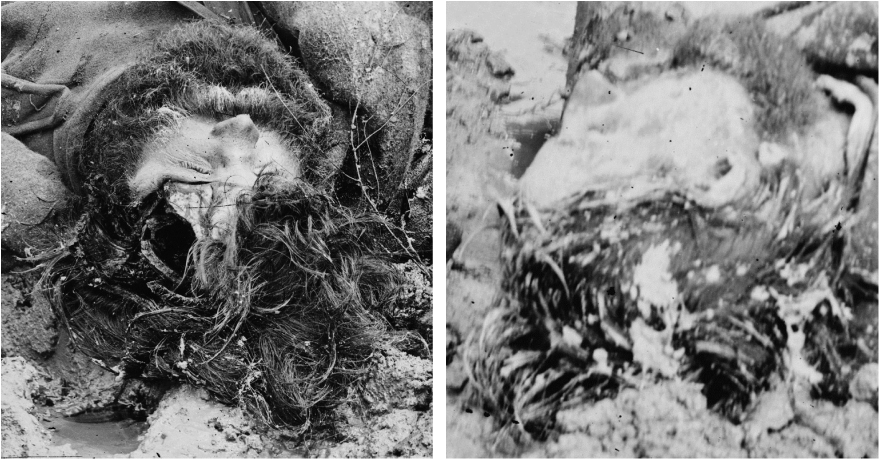
Pictures 168-169: Soldier 77 (left) has thick, full, wavy, auburn hair and beard. The heavy beard is no more than an inch long. He is probably in his twenties. Soldier 79 (right) similarly has thick, full, straight, auburn hair and beard. Like Soldier 77, his beard is not more than an inch long, and he, too, is in his twenties.
Taking
all of this evidence together, a typical Confederate soldier in the trenches at
the Battle of Petersburg would have been slim, in his early twenties, or late
teens, had a fairly short haircut, and no facial hair. He would have worn a black, wool felt
“British import” hat, a suit of cadet gray Richmond jacket with cadet gray or
domestic fabric pants, and standard, Jefferson-style brogans. He may have had a patterned shirt or a depot-issue,
white osnaburg shirt, but his drawers would have been white osnaburg. He would have worn his pant legs outside of
his natural white, woolen socks. He may
have worn a military style vest, made of jeans cloth, under his jacket. He would have carried either a P53 Enfield or
M1861 US rifle musket including a sling and bayonet. He would have had leather accoutrements to
include a waist belt with a harness buckle, a cartridge box on a shoulder belt,
and cap pouch and a bayonet scabbard. He
would have carried a haversack and a Confederate canteen on a narrow leather
strap over his right shoulder. His
blanket roll and gum blanket would have been carried separately. This would have completed the typical
soldier’s outfit on that fateful day: April 2, 1865.
As a final commentary, it is worth mentioning the soldiers' regimental affiliation. The part of the line photographed by Roche, which bore the brunt of the Union break through, had been held by mainly by Lane's North Carolina Brigade. The brigade consisted of the 18th, 28th, 33rd and 37th North Carolina Infantry Regiments. The 11th North Carolina Infantry of MacRae's Brigade was on the right of Lane's Brigade, and was also overrun in the general assault. It stands to reason that all of the fallen soldiers would have been North Carolinians. It is also noteworthy that none of them appear to be wearing North Carolina state issue jackets.
The fifteen fallen Confederates of Fort Mahone, immortalized by Thomas C. Roche’s images, remained faithful to the Cause to the very last. They sacrificed their lives in defense of home and hearth. While their Cause was lost, they did not die in vain. They bequeathed to their Southern descendants a legacy of valor, devotion to duty and impeccable honor. They will be honored, perhaps all the more because of Roche’s images, as long as there are Southerners to remember their sacrifice. May these fifteen fallen Confederates, the unwitting subjects of this study, rest in peace forevermore.
BIBLIOGRAPHY: All images herein are courtesy of the Library of Congress, photographer Thomas C. Roche collection. The Library of Congress image numbers corresponding to the soldier and assigned number, are as follows:
Soldier 75: LC-88171-3175
Soldier 76: LC-8811-3175 & 3178
Soldier 77: LC-8811-3177 & 3188
Soldier 79: LC-8811-3179
Soldier 80: LC-8811-3180, 3181 & 3191
Soldiers 82f & 82b: LC-8811-3182
Soldier 83f & 83b: LC-88171-3183
Soldier 84: LC-8811-3184 & LC 88184-4079
Soldier 85: LC-88184-3185 & LC-USZ62-95872
Soldier 86: LC-8811-3186 & LC-USZ62-111743
Soldier 87: LC-88184-3187
Soldier 89: LC-8811-3189 & LC-USZ62-112373
Soldier 90: LC-8811-3190
As a final commentary, it is worth mentioning the soldiers' regimental affiliation. The part of the line photographed by Roche, which bore the brunt of the Union break through, had been held by mainly by Lane's North Carolina Brigade. The brigade consisted of the 18th, 28th, 33rd and 37th North Carolina Infantry Regiments. The 11th North Carolina Infantry of MacRae's Brigade was on the right of Lane's Brigade, and was also overrun in the general assault. It stands to reason that all of the fallen soldiers would have been North Carolinians. It is also noteworthy that none of them appear to be wearing North Carolina state issue jackets.
The fifteen fallen Confederates of Fort Mahone, immortalized by Thomas C. Roche’s images, remained faithful to the Cause to the very last. They sacrificed their lives in defense of home and hearth. While their Cause was lost, they did not die in vain. They bequeathed to their Southern descendants a legacy of valor, devotion to duty and impeccable honor. They will be honored, perhaps all the more because of Roche’s images, as long as there are Southerners to remember their sacrifice. May these fifteen fallen Confederates, the unwitting subjects of this study, rest in peace forevermore.
BIBLIOGRAPHY: All images herein are courtesy of the Library of Congress, photographer Thomas C. Roche collection. The Library of Congress image numbers corresponding to the soldier and assigned number, are as follows:
Soldier 75: LC-88171-3175
Soldier 76: LC-8811-3175 & 3178
Soldier 77: LC-8811-3177 & 3188
Soldier 79: LC-8811-3179
Soldier 80: LC-8811-3180, 3181 & 3191
Soldiers 82f & 82b: LC-8811-3182
Soldier 83f & 83b: LC-88171-3183
Soldier 84: LC-8811-3184 & LC 88184-4079
Soldier 85: LC-88184-3185 & LC-USZ62-95872
Soldier 86: LC-8811-3186 & LC-USZ62-111743
Soldier 87: LC-88184-3187
Soldier 89: LC-8811-3189 & LC-USZ62-112373
Soldier 90: LC-8811-3190
This website and its content is copyright of Adolphus Confederate Uniforms.
© Adolphus Confederate Uniforms 2010-2021. All rights reserved.
Email us | Copyright | Disclaimer | Terms of Use | PDF Download Help
|
|
|
